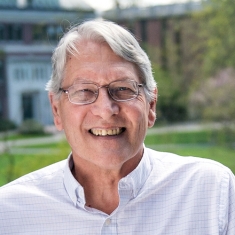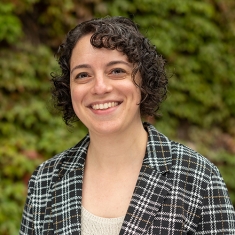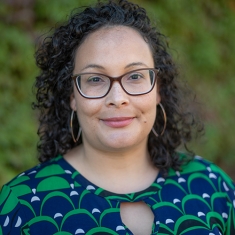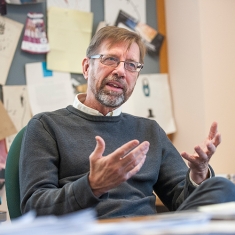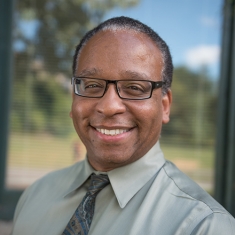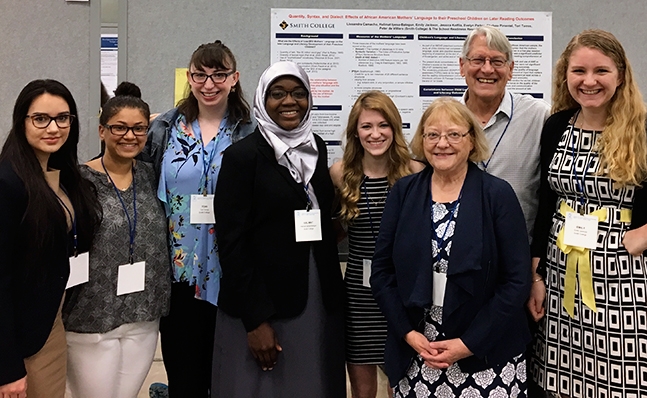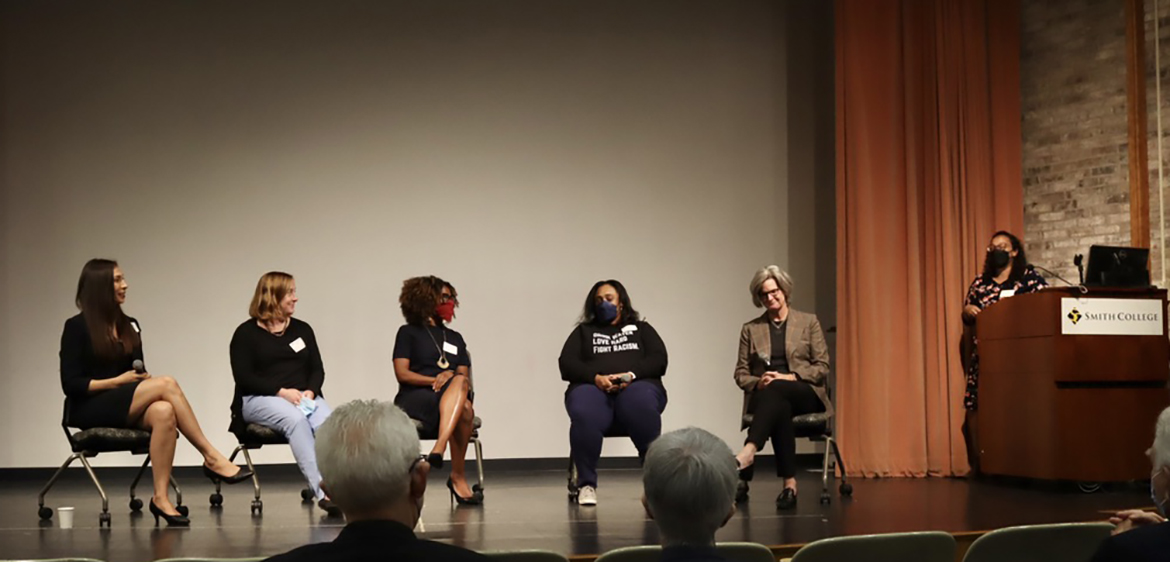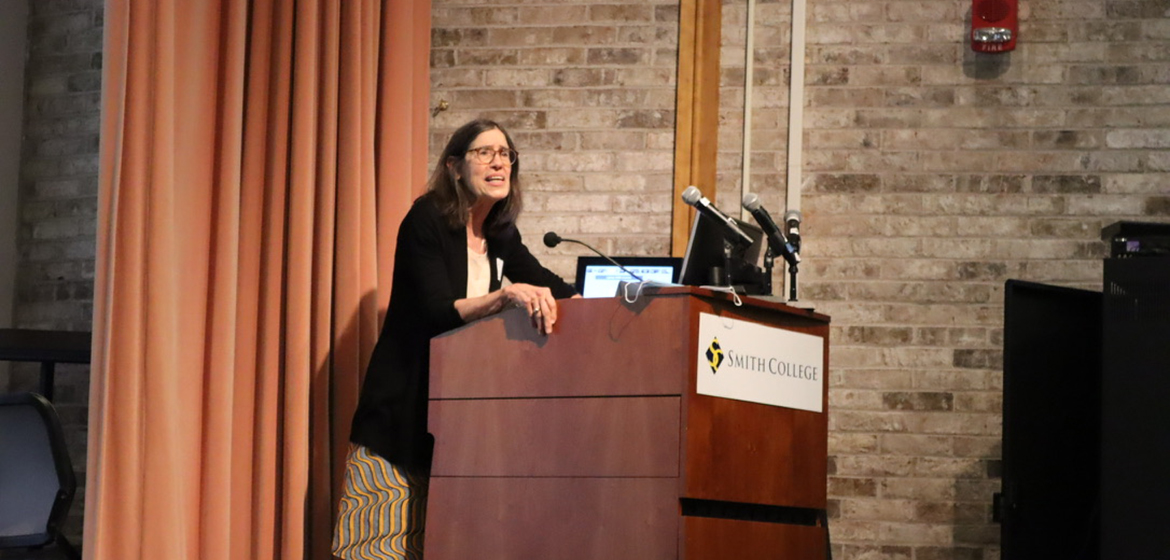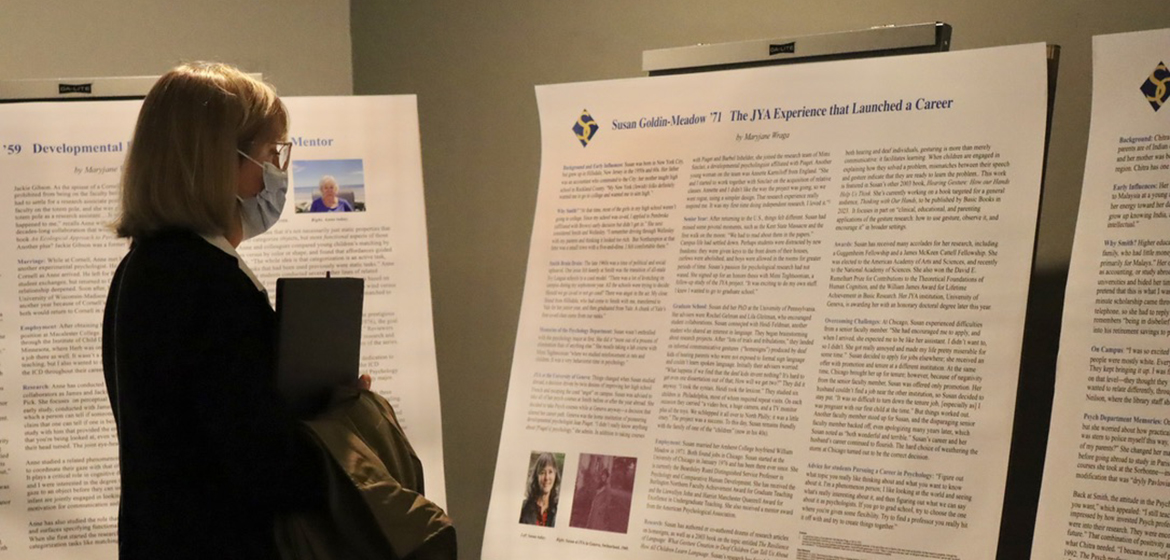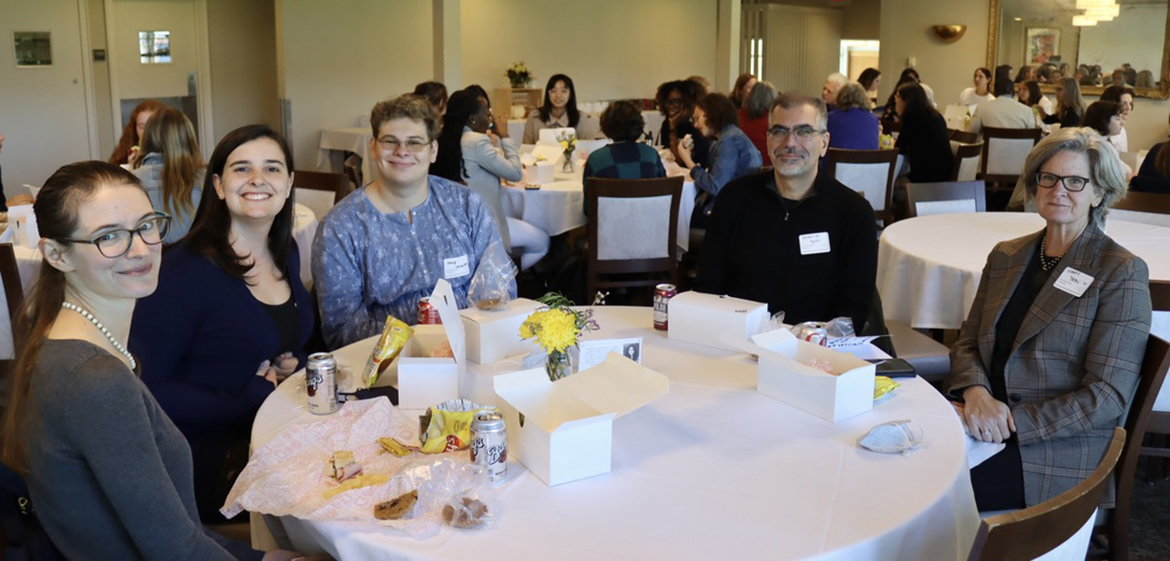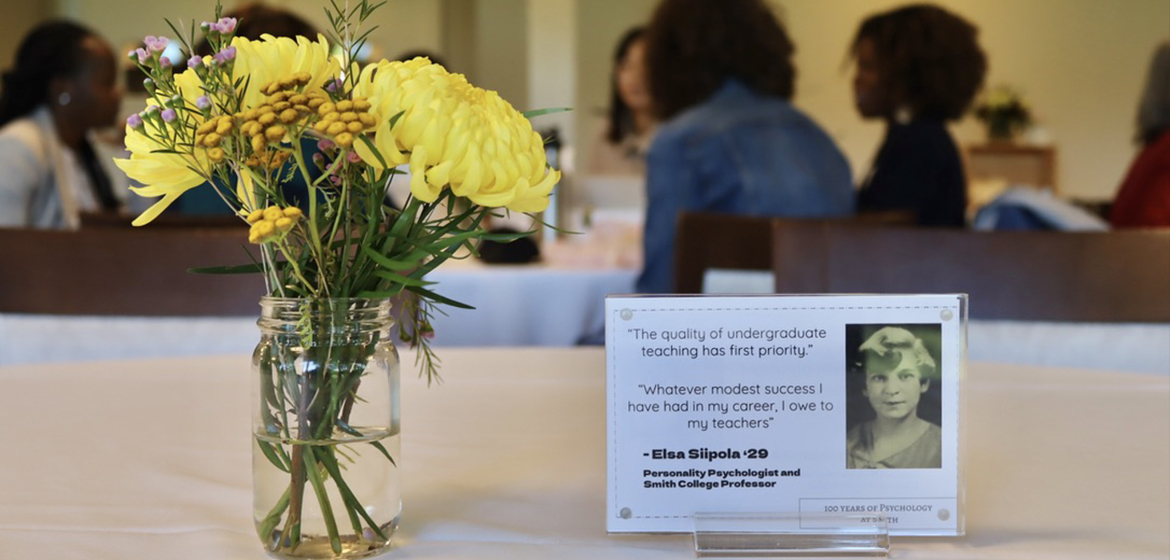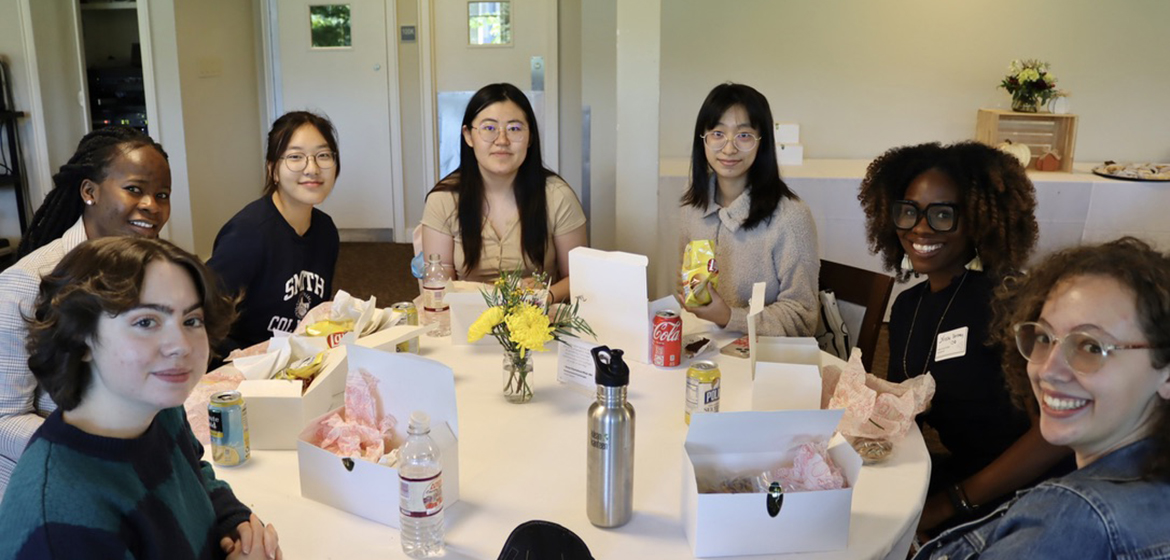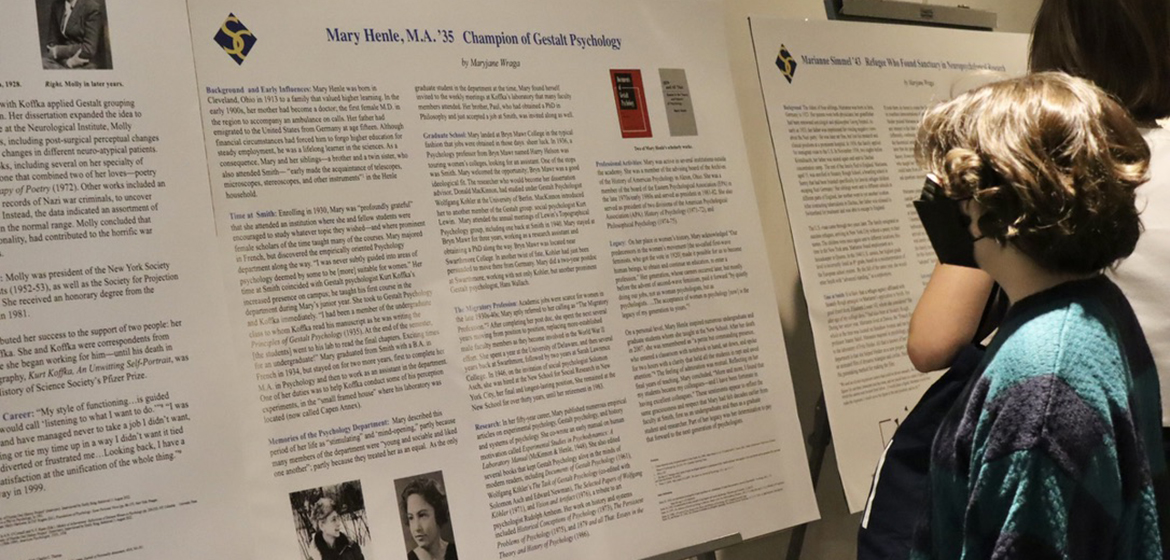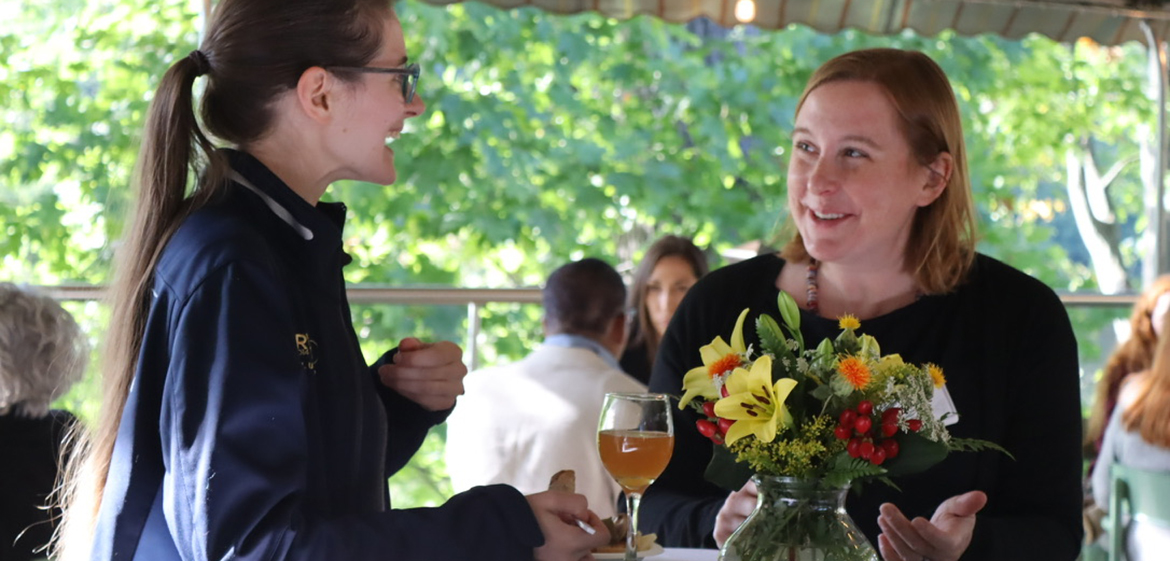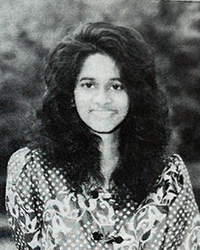Psychology

Psychology at Smith is consistently one of the most popular majors on campus. The department’s faculty is strongly committed to providing a rich, diverse curriculum to majors and nonmajors alike. Our mission is to develop skills that will serve students well in psychology but that can also be applied in other important arenas, including writing and communication skills, hands-on training and multicultural fluency. We emphasize student participation in research; faculty-student collaboration and mentoring; and preparation and guidance for future studies in psychology and related fields.
We’ve Turned 100!
In the 1922–23 academic year, the official founding of the Smith College psychology department—previously housed under the umbrella of the philosophy department—was a prescient and bold decision. We celebrated with a centennial symposium—a full day of events, lectures and discussions highlighting the pioneering efforts of Smith’s faculty, staff, students and graduates.
WATCH THE RECORDING VIEW A SLIDESHOW READ ALUM PROFILES
Announcements
Congratulations, Stephaney Perez '23!
Stephaney Perez '23 will be attending Georgetown University for the M.A. in Latin American Studies this fall. A double major in Psychology and Latin American Studies, she is the first in her family to attend graduate school and in a field about which she is deeply passionate.
Congratulations Caitlin Senni AC '23
Caitlin Senni AC '23 was awarded a GAANN fellowship to support her pursuit of a Ph.D. at the University of Connecticut.
Congratulations, Rosina Asiamah AC '23!
Rosina Asiamah, Ada Comstock Scholar '23 was awarded full funding and will be attending the University of Rochester School of Nursing one-year Accelerated Bachelor of Science in Nursing starting this fall.
Psychology department faculty affirmed the following learning goals for our majors. Students will:
- Develop a knowledge base of psychology, becoming familiar with the important theories, findings and historical perspectives in the field.
- Become critical consumers of research and learn to think critically about behavior, brain and mental processes; understand the relations among theories, observations and conclusions; and weigh evidence in evaluating particular theories or approaches.
- Develop research and quantitative fluency, including the ability to develop hypotheses, design studies, and understand, analyze and represent data.
- Develop requisite writing and communication skills within the discipline.
- Understand the ethics and philosophy of science.
- Develop multicultural fluency, including the ability to view issues from different cultural perspectives and to ask pertinent questions about cultural influences.
Each student, with the approval of their major adviser, elects course selections that meet the following requirements:
- Majors must take a minimum of 10 courses, including the foundational courses in psychology (100, 201, 202).
Basis
- PSY 100 Introduction to Psychology
- SDS 201 Statistical Methods
- PSY 202 Introduction to Research Methods
Foundational courses must be taken using the regular grading option (not S/U). Students should normally complete these foundational courses by the end of their sophomore year. Discuss requests for waivers (e.g., AP tests, transfer credits) with your adviser.
Beyond these, students are required to achieve breadth and depth across the following major curricular tracks of study:
- Mind and Brain
- Health and Illness
- Person and Society
Breadth is achieved by selecting one course within each of the department's three curricular areas. Depth is achieved by selecting at least two colloquia (psychology courses with numbers 200 or above) as well as two courses at the advanced level (300 or above), at least one of which is a seminar. Note that 200-level courses from other departments (such as EDC 238, ESS 220, EDC 239) count as psychology breadth courses but do not count as psychology colloquia. Furthermore, depth requires that at least one course at the advanced level combines with the student's other courses to create a constellation of three courses that represent a depth in a field of study that is important to the student and recognized by the department as relevant to psychology. Students may count no more than three 100-level courses toward the major, not including PSY100. Although we discourage the use of the S/U option for courses in the major, students are allowed to take nonfoundational courses S/U. All students (including transfer students) must take at least one colloquium and one advanced seminar within the department.
In particular, any student planning a career in academic or professional psychology, social work, personnel work involving guidance or counseling, psychological research or paraprofessional occupations in mental health settings or special education programs should regularly consult her major adviser regarding desirable sequencing of courses.
Finding an advisor
Students who wish to declare a psychology major should email the departmental assistant, Laura Fountain-Cincotta (lfountaincincotta@smith.edu), who will direct them to faculty who have space for advisees.
Each student, with the approval of their minor adviser, elects course selections that meet the following requirements:
- Six semester courses including two of the three courses that comprise the foundational courses for the major and four additional courses selected from at least two of the three areas. In addition, one of these four courses must be a colloquium and one must be a seminar. Note that 200-level courses from other departments (such as EDC 238, ESS 220, EDC 239) count as psychology breadth courses but do not count as psychology colloquia. All courses must be taken using the regular grading option.
Basis (only 2 of these are required):
- PSY 100 Introduction to Psychology
- SDS 201/PSY 201 Statistical Methods
- PSY 202 Introduction to Research Methods
The basis must be completed before entering the senior year. Minors must then complete no less than four additional courses from at least two of the department's three curricular tracks of study. One of these four additional courses must be a seminar.
- Mind and Brain
- Health and Illness
- Person and Society
The departmental honors thesis is for senior psychology majors interested in conducting independent research on a particular topic. Honors students work closely with a faculty member to conceptualize, design, and conduct an empirical research project. Please note: faculty members from outside the Smith Psychology department are not eligible to serve as thesis advisers; the principal adviser of a psychology honors thesis must be a Smith Psychology Department faculty member. The project culminates in a paper that is equivalent to a publishable journal article in quality and length (i.e., about 30-50 pages of text and written in APA style). At the end of the academic year, Honors students present their projects to the department as a whole. Successful completion of an Honors thesis leads to departmental honors upon graduation.
What are the eligibility requirements?
In order to be eligible for departmental honors, you must have a 3.3 GPA within your major and a 3.0 GPA average for courses outside your major. GPA calculations include all courses taken here at Smith, the Five Colleges and Smith JYA programs. Other transfer credits or JYA program courses are not included.
How should I prepare myself to do an honors thesis?
Students seriously contemplating conducting an honors thesis should begin talking to professors in their area of research interest during their junior year, at the latest. Many honors projects have developed from research that students have done with professors, either by volunteering in their laboratories or through special studies. Besides completing the requirements for the major, we recommend that students thinking about honors take an upper level seminar, laboratory or special studies in the area of research interest. We also strongly recommend that students take Advanced Statistics (PSY 290/MTH 290) during their junior or senior year.
How do I find an honors adviser?
There are several ways to find a faculty member to supervise your honors thesis. Most students begin by volunteering in a faculty member's research laboratory during their first or second years at Smith. This acquaints students with research topics and the nuts and bolts of the research process. Others approach professors of classes that they've especially enjoyed. When a student thinks she knows with whom she wants to work, that student should make an appointment to meet with the professor to discuss the possibility of doing an Honors thesis.
What if I can't find an adviser whose research interests match mine?
The psychology department consists of active researchers studying many exciting topics. Of course, it is possible that our faculty will not be studying the particular topic in which you currently are interested. In this case, you have two options. First, you can ask professors if they would be willing to supervise a thesis outside their area of expertise. Better yet, you can work with a professor to design an honors project that the professor feels comfortable supervising and satisfies your interests as well. We have found that the best experiences occur when student interests can be assimilated into the professor's established research program. Thus, the quality of your training will be enhanced by a good fit between your thesis topic and your adviser's area of expertise.
How do I get approval for honors?
First, you have to complete an application for honors. There are full instructions for the completion of this application on the class deans website. When you are done with your application, you submit it to the director of honors for the psychology department. To enter the honors program, you have to receive approval of your project from both the psychology department and the college's Subcommittee on Honors and Independent Programs (SHIP). First, the psychology department reviews and votes on your honors proposal. If you are approved at the departmental level, the honors director forwards your proposal to SHIP for review and approval.
Can I do honors if I go abroad junior year?
The answer is a most definite "yes," although it will take some planning on your part. You should be prepared to contact your potential adviser before you go away; another option is to approach your potential adviser via email while you are abroad. In any case, do not wait until the beginning of your senior year to make contact, as that will be unfeasible given the submission deadlines (see suggested timeline below).
How is an honors thesis different from special studies?
A special studies is a scholarly project conducted during the junior or senior year under the supervision of any member of the department. It can take the format of either a literature review or an empirical study, and can be worth between 1 to 4 credits. In contrast, the honors thesis is only conducted during the senior year and is subject to an outside approval process. It consists of an empirical study, which you must present before the psychology department in the spring. Presentations usually last 30 minutes, with an additional 20 minutes for questions. Honors theses are worth 12 credits, 6 per semester.
What are the benefits of doing a thesis?
The honors thesis provides you the unique opportunity of immersing yourself in a research project to greater depths than anything else you will experience in the psychology department. Many students report feeling great satisfaction from the experience of taking the lead on a research project, which the honors thesis affords. Your research and writing skills will improve immensely during the process. In addition, the experience may help you focus your research interests when considering a graduate career in psychology.
What are the disadvantages?
The greatest disadvantage is the time commitment, most of which falls during your senior year. The 12-credit requirement also obliges you to take fewer courses during your senior year, which may limit your options. Some students report being intimidated by the writing commitment. However, the psychology department recently has reduced the writing expectations of the final paper to that of a manuscript suitable for publication in a major empirical journal.
What resources are available to support my honors thesis research?
Financial assistance for honors research is available. You can procure funds from the Tomlinson Memorial Fund, administered by SHIP. To request assistance, you need to complete a Tomlinson application, which you receive from the class deans office with the honors application. The Tomlinson request requires a proposed budget and justification of expenses as well as a letter of support from your thesis adviser. You need to submit Tomlinson fund requests at the same time as your honors proposal.
You are required to complete a library instruction session for your honors project during the fall semester. This one-hour session provides instruction in use of the science library's resources to help with your research project.
How are honors evaluated?
First, you are graded by your thesis adviser for the honors credits (typically 12) included on your transcript.
In addition, an official honors designation is given to each thesis at the end of the project based on the student's grades within the major, oral defense of the project, and final written thesis. Two members of the psychology department (an "examiner" and the student's thesis adviser) evaluate the honors student's oral defense. Likewise, two faculty members (a "reader" and the student's thesis adviser) evaluate the honors student's written thesis. The director of honors chooses readers and examiners in consultation with each thesis student and her adviser.
Suggested Timeline for Completing an Honors Thesis
Prior to Spring Semester: Junior Year
- Volunteer in a faculty member's research lab
- Consider taking SDS 290 or PSY 301 (Advanced Statistics) in your junior year
- Take an upper level seminar, laboratory course, or special studies in your area of research interest
Spring Semester: Junior Year
- Find a faculty adviser and create a research plan
- Consider seeking honors approval this semester, rather than waiting until next fall
- Plan courses for senior year; consider taking SDS 290/PSY 301 (Advanced Statistics), if you have not already
Fall Semester: Senior Year
- Submit honors application to the Psychology by the date designated by the director of honors
- Procure Independent Review Board (IRB) approval
- Complete library instruction session
Spring Semester: Senior Year
- Submit expense receipts for the Tomlinson fund, typically by mid-April
- Submit thesis to the department on the deadline determined by SHIP
- Present thesis to psychology department during the last week of classes
- Submit final departmental copy of thesis to the honors director and final library copy to SHIP by the first week in May
The psychology curriculum is structured to develop the skills and objectives set forth in the department's learning goals. Courses are generally organized around the following tracks of study:
- Mind and Brain
- Health and Illness
- Person and Society
These tracks of study have been designed into the requirements for the department's major and minor and are clearly reflected in the courses offered by the department.
Mind and Brain
- PSY 120 Introduction to Cognitive Science
- NSC 125 Sensation and Perception
- NSC 210 Fundamentals of Neuroscience
- EDC 238 Introduction to Learning Sciences
- PSY 209/PHI 209 Philosophy and History of Psychology
- PSY 213/PHI 213 Language Acquisition
- PSY 215 Brain States
- PSY 216 Understanding Minds
- PSY 218 Cognitive Psychology
- PSY 225 Memory in Literature
- PSY 227 Brain, Behavior, and Emotion
- PSY 312 Calderwood Seminar: Psychology in the Public Square
- PSY 313 Psycholinguistics
- PSY 314 Cognition in Film
- PSY 315 Autism Spectrum Disorders
- PSY 317 Seminar in Cross-Cultural Psychology
- PSY 319 Research Seminar in Adult Cognition
- PSY 320 Research Seminar in Biological Rhythms
- PSY 326 Seminar in Biopsychology
- PSY 327 Seminar in Mind and Brain
Health and Illness
- PSY 130 Clinical Neuroscience
- PSY 140 Health Psychology
- PSY 150 Abnormal Psychology
- ESS 220 Psychology of Sport
- EDC 239 Counseling Theory & Education
- PSY 230 Psychopharmacology
- PSY 240 Health Promotion
- PSY 250 Culture, Ethnicity, Mental Health
- PSY 253 Developmental Psychopathology
- PSY 287 Evidence-Based Practice
- PSY 340 Psychosocial Determinants of Health
- PSY 350 Seminar in Culture, Ethnicity, and Mental Health
- PSY 352 Seminar in Advanced Clinical Psychology
- PSY 353 Seminar in Developmental Psychopathology
- PSY 354 Seminar in Advanced Abnormal Psychology
- PSY 355 Practicum Seminar in Clinical Psychology
- PSY 358 Research Seminar in Clinical Psychology
Person and Society
- PSY 165 Adult Development
- PSY 166 Psychology of Gender
- PSY 170 Introduction to Social Psychology
- PSY 180 Personality Psychology
- EDC 235 Child and Adolescent Growth and Development
- PSY 263 Psychology of the Black Experience
- PSY 264 Lifespan Development
- PSY 265 Political Psychology
- PSY 266 Psychology of Women and Gender
- PSY 267 Moral Psychology
- PSY 268 Human Side of Climate Change
- PSY 269 Intergroup Relations
- PSY/REL 304 Happiness: Personal Wellbeing
- PSY 360 Peer Relationships
- PSY/SDS 364 Research Seminar on Intergroup Relations
- PSY 368 Seminar in Identity Development
- PSY 371 Seminar in Personality
- PSY 373 Research Seminar in Personality
- PSY 374 Seminar on Political Activism
- PSY 375 Research Seminar on Political Psychology
- PSY 376 Seminar in Psychology and Law
Additional Courses
- PSY 301 Advanced Research Design and Analysis
- PSY 345 Feminist Perspectives on Psychological Science
Following college precedent, the current curriculum of the Department of Psychology is organized into 100-level introductory courses, 200-level content courses, 300-level labs and seminars and 400-level special studies and honors projects.
In some cases, students also design unique courses of study by incorporating additional classes from other Smith departments, Five College classes not offered at Smith, junior year abroad experiences and original research in the field.
See the Smith College Course Catalog for complete course listings. Students can also take courses through the Five Colleges.
Faculty
Research & Opportunities
Research Opportunities
A continuing goal of the department is to offer significant original research opportunities for declared majors and minors, working closely one-on-one or in small collaborative groups with members of the faculty.
Why Do Research?
Research is a great way of developing and learning new skills. It is an opportunity to acquire experiences that would not be possible to gain any other way. Participating in research allows you to learn about topics in a more complex and practical manner, which cannot be obtained simply from reading a book. These forms of experiences can come from working independently or from being part of a collaboration.
Being involved in research also allows you to develop professional relationships, and is a great way of obtaining mentoring. Your role is simply to acquire the most you can from your research opportunities. Working with faculty on their research not only benefits them, but also serves you well in developing your own research interests. It allows you to see what you are most interested in and how you can further develop these interests. Understanding how to successfully conduct research here at Smith is a valuable and rewarding experience.
Obtaining Psychology Research Experience at Smith
Take a Laboratory Psychology Course
Research experience can be obtained by taking a laboratory course in any areas of psychology. By taking a lab course, you'll learn about the steps needed to conduct a research study. This is a great way to obtain research experience while also earning course credit.
Volunteer in a Faculty Member's Lab
Sometimes faculty do not have paid positions available but do welcome students who are willing to volunteer in their labs. Volunteering in a lab can help you become familiarized with different aspects of research (e.g., running experimental sessions, conference presentations, etc.).
Most faculty members only require that you are motivated to learn from them, and assist them with different aspects of conducting the research they need to conduct.
Undertake an Independent Study
Students can earn upper-division credits for participating in a special studies or honors thesis project with a member of the faculty. To do so, it is advisable to approach a faculty member early in your college career, take courses that will be valuable for completing your own project (for example, Advanced Stats) and work with that faculty member in some ongoing research capacity.
Become a Paid Research Assistant
All active faculty in the department have ongoing research programs. Each year, faculty presents new findings at national and international meetings of learned societies and publishes copiously in scholarly journals. We are eager to involve our majors and premajors in our research. It is a valuable opportunity to learn at first hand the technical skills of doing research in psychology, the methods of processing findings, and the style of preparing manuscripts and posters for publication and presentation. These positions are generally paid prevailing rates for student assistants.
Become a Paid Summer Research Fellow
Every summer, the Clark Science Center awards summer research fellowships, which provide students the opportunity to work with faculty on their research while also receiving a stipend. Faculty members usually take on fellows if they have had them in a class or have worked with them in some sort of prior research context. Students should seek this opportunity by talking with faculty about their interest in such a program. A call for application submissions is announced every spring, so students should be looking out for this opportunity early in the spring semester. This allows sufficient time to talk to a faculty member and then submit a cogent proposal.
Learn more about how to get started in research at Smith College.
In addition to research opportunities, there are a number of other opportunities available to Smith students during the course of the academic year. Here are just a few:
Teaching Assistantships
The success of our introductory course (PSY 100) depends on the contribution of paid student assistants or proctors. Teaching assistants may participate in and lead small group discussion, advise students on the selection and development of paper topics, do interview testing and work with students on their oral presentations. By participating in a general review of psychology, senior majors develop a coherent overview of the diverse areas that constitute psychology today. For those who are planning to apply to graduate school, teaching assistantships provides an excellent review for the Graduate Record Examinations.
Membership in Psi Chi
The psychology department at Smith has established, nurtured and grown a large and active chapter of Psi Chi, The National Honor Society in Psychology. Founded in 1929 for the purpose of "encouraging, stimulating, and maintaining excellence in scholarship of the individual members in all fields, particularly psychology, and advancing the science of psychology," Psi Chi is a national organization comprised of local chapters on more than 600 college and university campuses.
Psi Chi provides academic recognition to its initiates by fact of membership. On a larger scale, local chapters of Psi Chi offer a nurturing climate towards creative development. These local chapters provide programs designed to stimulate and nourish professional growth. Annual national and regional conventions are held in conjunction with other psychological associations. Psi Chi also offers research award competitions, certificate recognition programs and a quarterly newsletter. Psychology majors wishing to apply for membership in Psi Chi at Smith College should visit the organization's website. All applications must be received by mid-February.
Student Liaisons
Psychology majors are selected as representatives who attend psychology department meetings, cast a vote on departmental decisions, and are asked to represent student interests on a wide variety of matters, such as the structure and contents of the curriculum and new faculty hiring. We see our students as participants in the governance of the department. Applications to be selected as a student liaison are sent to psychology majors in September.
[Conference content forthcoming soon]
Facilities
The Department of Psychology at Smith is housed in Bass Hall, with state-of-the-art laboratories and work areas. These include:
Laboratories
Statistics, Experimental Psychology, Health Psychology, and Psychophysiology
In the basement of Bass Hall, there are general laboratories for statistics and experimental psychology. The statistics laboratory is equipped with computers (with dual Windows and Mac OS capabilities) that are also used in courses such as Research Methods. On this floor too are laboratories for health psychology and psychophysiology.
Language Acquisition, Developmental Psychology, and Psychology of Women
On the second floor of Bass Hall are the laboratories for language acquisition, developmental psychology, and psychology of women. In addition, a well-equipped video analysis facility exists for viewing, transcribing, and editing video recordings of behavior.
Cognitive Psychology, Social Psychology, Personality Psychology, and Clinical Psychology
The third floor of Bass Hall contains extensive laboratories for research in cognitive psychology, social psychology, personality psychology, and clinical psychology.
Young Library
On the first floor of Bass Hall, the Young Library is richly equipped for students of psychology, including an excellent collection of both books and journals. Computerized literature searching is also available.
Seminar Room/Lounge
On the fourth floor there is a comfortable seminar room/lounge named in memory of alumna Gale Curtis.
Science Center Animal Quarters
The Science Center maintains Animal Quarters with several species of small laboratory animals, and laboratory space for behavioral experiments adjoins that space.
Smith College Campus School
Students of child development and language acquisition will have the opportunity to observe and conduct approved studies with children in the preschool (Fort Hill) and the Smith College Campus School.
Smith & Five College Resources
Summer and PostBac Research Opportunities List
A list curated by Smith College Psychology Faculty of opportunities for students to gain research experience outside of Smith.
PSYCINFO Online Research Service
This is a direct link to the library's PsychInfo site. You need to be logged on to a Smith College system computer to access this invaluable online resource.
Smith Library Online Psychology Resources
An important link to a number of online resources, websites and journals available through Smith's central library system.
An important link to many online research resources, articles and tools available throughout the Five College system.
Other Resources
American Psychological Association (APA) Style
An excellent resource for additional information about APA style questions.
Association for Psychological Science
This international organization is dedicated to advancing scientific psychology across disciplinary and geographic borders.
This site has a wide range of information for any students who are interested in learning more about what a degree in psychology can do for your future. There are job postings, license requirement information for all 50 states, interesting interviews and more.
A rich resource that aims to make psychology more transparent and open by providing lists of opportunities such as paid internships, virtual graduate school information sessions, post-baccalaureate jobs, and resources for applying to graduate school.
How Research Can Make a Difference
The Society for Research in Child Development has created a series of videos called “Hidden Figures” in Developmental Science to increase the visibility of leading developmental scientists of color who have made critical research contributions. To learn more, start by watching this video on “Increasing Awareness of Developmental Science.”
Hands-On Research Opportunities
Smith psychology majors often have an opportunity to present their research projects, such as these students showcasing a poster at the Society for Research in Child Development convention with professors Jill and Peter de Villiers.
Research at Smith
100 Years of Smith Psychologists
The profiles are listed chronologically and reflect developments within the field as well as the department. See what these alums have to say about their time in the department, their research, overcoming obstacles, and advice for undergrads. (Yearbook photos courtesy of Smith College Special Collections.)
Elsa Siipola ’29
Student, Teacher, Researcher, Leader
Background and Early Influences: Elsa Siipola was born in Fitchburg MA in 1908, the daughter of a clerk and department-store window trimmer and a homemaker mother. She was an outstanding high school student, and her teachers encouraged her to apply to Smith. She was able to enroll thanks to scholarships from Smith and the Fitchburg Smith Club, as well as her earnings and savings.
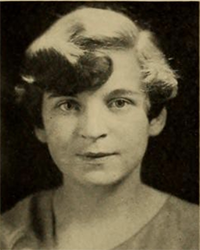
Graduate School: Elsa was promoted to Assistant Professor in 1934. She decided to pursue a PhD in Psychology, choosing Yale because of its interdisciplinary Institute of Human Relations. “I had planned, especially, to attend Clark Hull’s seminar relating behaviorism and psychoanalysis, as well as a course on psychoanalysis taught by my friend Earl Zinn,” she recalled. However, these plans did not pan out. “Hull, the dominant force at Yale at that time, called me to tell me that women were not eligible to take either course. I was shocked and felt cheated.” Hull held other biases as well. While Elsa was graduate student and instructor at Smith, she had attended Kurt Koffka’s weekly seminar on Gestalt Psychology. Koffka had even entrusted her with taking over the undergraduate version of the course when he was ill. At Yale, Hull would refer to Elsa as “the damned Gestalt psychologist,” though this was probably more a case of guilt by association than any actual identification as a Gestaltist.
Back to Smith: Elsa completed her PhD in 1939. In the same year, “after a decade of happy courtship,” she and colleague Harold Israel married. She felt a renewed need for training: “After our marriage I [thought] I should establish my own identity and find an area of psychology different from Harold’s.” Thus, she began postdoctoral work in personality psychology at Harvard, where she studied with Gordon Allport. She also studied psychodynamic and psychoanalytic theory with Henry Murray, then director of the Harvard Psychological Clinic. Following a stint at the Rorschach Research Institute in 1941, she began experimental work on projective tests (her first subject for the Rorschach was Smith Psych major Betty Goldstein ‘43 [later Friedan]. “She took eight hours.”) Elsa used a sabbatical in 1948-49 to study at Worcester State Hospital’s Research Division and later at UCLA. Thereafter she settled into a long career at Smith’s Department of Psychology. She was appointed Associate Professor in 1945 and Professor in 1954 and served as chair of the department several times. She retired in 1973.
Research interests: Elsa is best known for her research on projective techniques, especially the Rorschach. She brought experimental rigor to the challenge of determining general principles by designing a “deliberate program for varying drastically the inviolate conditions of some prominent projective techniques.”2. For example, how does time pressure—or lack of it—affect participants’ responses? Her studies revealed that different “associative products” occur when participants have unlimited time to take the test: “The associative process undergoes a fundamental change in character rather than merely being slowed in pace.”3 In these studies and others, she sought principles that could apply generally to projective techniques—whether word associations or ink blots—and shed light on what is going on when participants interpret test items.
Teaching: Elsa’s intensive study of personality via projective testing led to a teaching focus on personality and depth psychology. For example, in 1949, she co-taught general psychology, served as director of the honors program, taught introduction to experimental psychology, a course on personality, and a seminar in the psychology of personality that included supervised practice with projective techniques. Quite an impressive workload! In the 1950s and 1960s, she continued to combine teaching of the introductory course with courses and seminars in personality. In an era when visual aids in the classroom usually consisted of chalk marks on a blackboard, Siipola’s vivid diagrams of ego, id, and superego stood out. They covered pages of my [Leah Holden’s] notebooks and made personality structures memorable. Upon her retirement, she reflected on teaching at Smith, where “the quality of undergraduate teaching has first priority.”4 It is clear how important teaching was to her, both as a professor and a student. “I…had gifted teachers at Smith, and at Yale when studying for my PhD, and later at Harvard….Whatever modest success I have had in my career, I owe to my teachers.”
Leadership: Elsa’s multiple terms as chair of the department gave her ample opportunity to leave a mark on it. She found a way to lead collaboratively. For a time, she and colleagues William Taylor and Harold Israel devised a system for governing by triumvirate—no matter which of the three was named chair—by having themselves appointed to the long-range planning committee. “The procedure had many virtues. It provided long-range planning. It resolved privately strong disagreements among full professors. It prevented the building up of factions within the department. It was efficient. The plans submitted usually obtained a majority vote, since three positive votes were secured in advance.” She extended her skills to the community through positions on the Governor’s Advisory Committee on Service to Youth, the National Science Foundation’s Committee on Undergraduate Science Instruction, and the Board of Directors of the Smith College Alumnae Association. She also served the college through her membership on the Post-War Planning Committee and by helping to create the Smith College Medal.
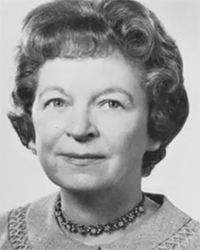
Footnotes
1 Except as noted, all quotes come from a 1981 interview of Elsa Siipola by Fran Volkmann, recording and transcription in Smith College Archives.
2 Siipola, Walker & Kolb 1955, p. 441
3 Sippola et al. 1955, p. 445
4 Elsa Siipola, “Looking back,” undated handwritten manuscript, Smith College Archives.
5 Interview of Peter Pufall and Don Reutner by Leah Holden, June 2018.
6 Diedrick Snoek, “Elsa Margareeta Siipola, Professor Emeritus of Psychology,” in the Smith Alumnae Quarterly, 1973.
7 The current Harold Edward Israel and Elsa Siipola Israel Professor of Psychology is Nnamdi Pole.
Select Publications
Fiester, S., & Siipola, E. (1972). Effects of time pressure on the management of aggression in TAT stories. Journal of Personality Assessment, 36(3), 230-240.
Siipola, E. (1940). Implicit or partial reversion errors: a technique of measurement and its relation to other measure of transfer. Journal of Experimental Psychology 26, 53-73.
Siipola, E., & Israel, H.E. (1933). Habit-interference as dependent upon stage of training. American Journal of Psychology 45, 205-227.
Siipola, E., & Taylor, V. (1952). Reactions to ink blots under free and pressure conditions. Journal of Personality, 21, 22-47.
Siipola, E., Walker, N., & Kolb, D. (1955). Task attitudes in word association, projective and nonprojective. Journal of Personality, 23, 441-459.
Molly Harrower Ph.D. ’34
From Socialite to Secretary to Psychologist
Background: Mary “Molly” Harrower was born in 1906 to Scottish parents. She grew up in a small village outside of London. As a girl she was an avid writer of fiction and would eventually publish a play and a book of poems called Plain Jane. Despite these proclivities and the fact that several family members had been prominent academics, her parents never considered Molly suitable material for university. The sole reason? Her gender. At age seventeen, Molly was instead sent to finishing school in Paris, to be prepared for becoming “the good wife of a wealthy gentleman.”1 She found the entire experience “miserable,” and credited her parents’ wisdom for taking her out of the school after the first semester and sending her to Switzerland to study French instead. Molly soon realized that she wanted to pursue higher education. Unfortunately, her debutante credentials fell far short of the highly competitive and rigorous British requirements for applying to college. Through a family friend at the University of London, she learned of a program at its constituent Bedford College—a three-year academic diploma in Journalism that didn’t require entrance exams. Molly got in and began fulfilling the journalism requirements, taking several courses in Psychology along the way. One of her Psychology professors, Beatrice Edgell,2 recommended that she switch her focus to Psychology. Molly happily complied. Before her final year, financial misfortune befell her family, and Molly had to withdraw from the program. She left in 1926 with just two of the three years of coursework completed.
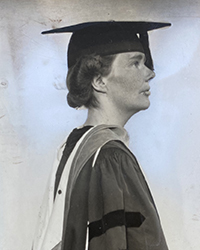
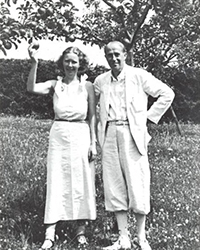
Other Smith Memories: Molly was popular on campus. “With my British heritage and an intimate knowledge of the Gilbert and Sullivan operas, I was asked to direct a student performance of the Mikado and acted in the faculty’s production of Trial by Jury.” She also has fond memories of hiking in Hampshire County. “Excursions into the surrounding country were almost unbelievable to someone brought up within the confines of Greater London.”5
Early Neuropsychologist: In 1937, after a three-year stint as Director of Students at Douglas College, Molly used a scholarship she had received from the Rockefeller Medical Foundation to work on research that connected two disparate fields at that time: psychology and medicine. She first worked with neurologist Kurt Goldstein at Montefiore Hospital in New York City (where she wasn’t allowed to eat in the doctor’s dining room because of her gender), and then neurologist Wilder Penfield at the Montreal Neurological Institute. From 1938-1942, her job as the staff psychologist at the institute was to monitor patients (operated on by Penfield) for post-surgical cognitive and emotional changes. It wasn’t an easy task. She was “the only woman in the hospital, the only woman fellow, the only woman on the staff, and the only psychologist. It was a very lonely and extraordinary time.”6 In addition to publishing her findings, Harrower developed and copyrighted a group version of the Rorschach test that could be administered to hundreds of patients at a time. In 1938, Molly married Penfield’s assistant, neurosurgeon Theodore Erickson. In 1942, they moved to his new position at the University of Wisconsin-Madison; however, nepotism rules at the university precluded her (as Erickson’s wife) from working there. This caused tension in the marriage, and they divorced in 1944.
Contributions to the War Effort: During World War II, Molly became a consultant to several U.S. military organizations interested in her group Rorschach test. As a consultant for the Surgeon General’s Office, she developed another diagnostic tool called the stress tolerance test—an offshoot of her Rorshach—that was administered to soldiers to assess whether they were mentally fit to go back to battle after exposure to trauma. She would consult for several other organizations throughout her career.
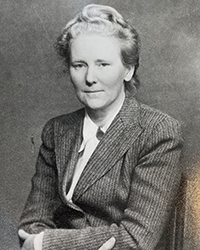
Professional Activities: Molly was president of the New York Society of Clinical Psychologists (1952-53), as well as the Society for Projection Techniques (1941-42). She received an honorary degree from the University of Florida in 1981.
Mentors: Molly attributed her success to the support of two people: her mother and Kurt Koffka. She and Koffka were correspondents from 1927—shortly before she began working for him—until his death in 1941. Her 1984 biography, Kurt Koffka, An Unwitting Self-Portrait, was nominated for the History of Science Society’s Pfizer Prize.
Secret to a Happy Career: “My style of functioning…is guided entirely by what I would call ‘listening to what I want to do.’”8 Throughout her career, she was “free to be myself, and have managed never to take a job I didn’t want, never to do anything or tie my time up in a way I didn’t want it tied up…nothing has diverted or frustrated me…Looking back, I have a feeling of great satisfaction at the unification of the whole thing.”9 Molly died in 1999.
Footnotes
1 Harrower, M. (26 November 1982). "University of Florida Oral History Project" (Interview). Interviewed by Emily Ring. Retrieved 11 August 2022.
2 Edgell was the first woman in Britain to receive a PhD in Psychology, in 1901.
3 Harrower, M. (1984). Memories and milestones: Molly Harrower. In D.P. Rogers (Ed.), Foundations of Psychology: Some Personal Views (pp. 98-137). New York: Praeger.
4 Harrower, M. (1984), p. 105.
5 Harrower, M.R. (1983). Molly R. Harrower. In A.N. O’Connell and N. F. Russo (Eds.). Models of Achievement: Reflections of Eminent Women in Psychology (pp. 220-232). NY: Columbia University Press.
6 Harrower, M. (26 November 1982). "University of Florida Oral History Project" (Interview). Interviewed by Emily Ring. Retrieved 11 August 2022.
7 Dewsbury, D.A. (2000). Molly R. Harrower (1906-1999). American Psychologist, 55(9), 1058.
8 Harrower, M.R. (1983). Molly R. Harrower. In A.N. O’Connell and N. F. Russo (Eds.). Models of Achievement: Reflections of Eminent Women in Psychology (pp. 220-232). NY: Columbia University Press.
9 Harrower, M. (26 November 1982), p. 18.
Select References
Harrower, M. (1961). The Practice of Clinical Psychology. New York: Charles C. Thomas.
Harrower, M. (1972). The Therapy of Poetry. New York: Charles C. Thomas.
Harrower, M. (1976). Rorschach records of the Nazi war records: An experimental study after thirty years. Journal of Personality Assessment, 40(4), 341-351.
Harrower, M. (1986). The Stress tolerance test. Journal of Personality Assessment, 50(3), 417-427.
Koffka, K., & Harrower, M.R. (1931). Colour and organization, part I. Psychologische Forshung, 15, 145-192.
Champion of Gestalt Psychology
Background and Early Influences: Mary Henle was born in Cleveland, Ohio in 1913 to a family that valued higher learning. In the early 1900s, her mother had become a doctor; the first female doctor in the region to accompany an ambulance on calls. Her father had emigrated to the United States from Germany at age fifteen. Although financial circumstances had forced him to give up plans of higher education for steady employment, he was a lifelong learner in the sciences. As a consequence, Mary and her siblings—a brother and a twin sister— “early made the acquaintance of telescopes, microscopes, stereoscopes, and other instruments”1 in the Henle household.
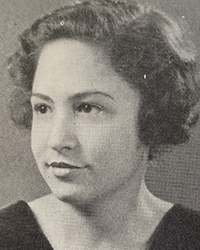
Mary graduated from Smith with a B.A. in French in 1934, but stayed on for two more years, first to complete her M.A. in Psychology and then to work as an assistant in the department. One of her duties was to help Koffka conduct some of his perception experiments, in the “small framed house” off campus where his laboratory was located (now called Capen Annex).
Memories of the Psychology Department: Mary described this period of her life as “stimulating” and ‘mind-opening,” partly because many members of the department were “young and sociable and liked one another”; partly because they treated her as an equal. As the only graduate student in the department at the time, Mary found herself invited to the weekly meetings at Koffka’s laboratory that many faculty members attended. Her brother, Paul, who had obtained a PhD in Philosophy and just accepted a job at Smith, was invited along as well.
Graduate School: Mary landed at Bryn Mawr College in Pennsylvania in the typical way that research jobs were obtained in those days: sheer luck. In 1936, a Psychology professor from Bryn Mawr named Harry Helson was touring women’s colleges, looking for an assistant. One of the stops was Smith. Mary welcomed the opportunity; Bryn Mawr was a good ideological fit. A researcher there who would become her dissertation advisor, Donald MacKinnon, had studied under Gestalt Psychologist Wolfgang Kohler at the University of Berlin. MacKinnon introduced her to another member of the Gestalt circle: social psychologist Kurt Lewin. Mary attended the annual meetings of Lewin’s Topographical Psychology group, including one back at Smith in 1940. Mary stayed at Bryn Mawr for three years, working as a research assistant and obtaining a PhD along the way. In another twist of fate, Kohler had just been persuaded to move from German to nearby Swarthmore College. Mary did a two-year postdoc at Swarthmore, working with not only Kohler, but another prominent Gestalt psychologist, Hans Wallach.
The Migratory Profession: Academic jobs were scarce for women in the late 1930s-40s; Mary aptly referred to her calling as “the Migratory Profession.”2 After completing her post doc, she spent the next several years moving from position to position, replacing more-established male faculty as they become involved in the World War II effort. She spent a year at the University of Delaware, and then several years back at Swarthmore, followed by two years at Sarah Lawrence College. In 1946, on the invitation of social psychologist Solomon Asch, she was hired at what was then called the New School for Social Research, in New York City, her final and longest-lasting position. She remained at the New School for over thirty years, until her retirement in 1983.
Research: In her fifty-year career, Mary published numerous empirical articles on experimental psychology, Gestalt psychology, and history and systems of psychology. She co-wrote an early manual on human motivation called Experimental Studies in Psychodynamics: A Laboratory Manual (McKinnon & Henle, 1948). She also edited several books that kept Gestalt Psychology alive in the minds of modern readers, including Documents of Gestalt Psychology (1961), Wolfgang Köhler’s The Task of Gestalt Psychology (co-edited with Solomon Asch and Edward Newman), The Selected Papers of Wolfgang Köhler (1971), and Vision and Artifact (1976), a tribute to Rudolph Arnheim. Her work on history and systems included Historical Conceptions of Psychology (1973), The Persistent Problems of Psychology (1975), and 1879 and all That: Essays in the Theory and History of Psychology (1986).
Professional Activities: Mary Henle was active in several institutions outside the academy. She was a member of the advising board of the Archives of the History of American Psychology in Akron, Ohio. Henle was a member of the board of the Eastern Psychological Association (EPA) in the late 1970s/early 1980s and served as president in 1981-82. She also served as president of two divisions of the American Psychological Association (APA): History of Psychology (1971-72), and Philosophical Psychology (1974-75).
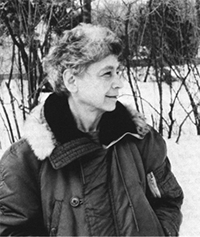
On the personal level, Mary Henle inspired numerous undergraduate and graduate students whom she taught at the New School. After her death in 2007, she was remembered as “a petite but commanding presence, who entered a classroom with notebook in hand, sat down, and spoke for two hours with a clarity that held all the students in rapt and awed attention.”4 The feeling of admiration was mutual. Reflecting on her final years of teaching, Mary concluded, “More and more, I found that my students became my colleagues—and I have been fortunate in having excellent colleagues.” These sentiments appear to reflect the same graciousness and respect that Mary had felt decades earlier from faculty at Smith, first as an undergraduate and then as a graduate student and researcher. Part of her legacy is that she paid that forward to the next generation of psychologists.
Footnotes
1 Unless otherwise noted, all quoted material is from Henle, M. (1983). Mary Henle. In A.N. O’Connell and N. F. Russo, Eds. Models of Achievement: Reflections of Eminent Women in Psychology (pp. 220-232). NY: Columbia University Press.
2 Henle (1983), p. 225.
3 The idea of a “between-wave” group of quiet but diligent feminists is reminiscent of the “stealth feminism” label applied to Tomi-Ann Roberts and her generation fifty years later (see Tomi-Ann Roberts ’85 profile).
4 Porac, C. (2009). Mary Henle (1913-2007). The American Journal of Psychology, 122, 1, pp. 111-113.
Select Publications
Henle, M. (1942). An experimental investigation of past experience as a determinant of visual form perception. Journal of Experimental Psychology, 30(1), 1-22. https://doi.org/10.1037/h0056500
Henle, M. (1944). An examination of some concepts of topological and vector psychology. Character and Personality, 12, 244-255.
Henle, M. (1977). The influence of Gestalt psychology in America. Annals of the New York Academy of Sciences, 299,1, 3-12. https://doi.org/10.1111/j.1749-6632.1977.tb53054.x
Henle, M. (1986). 1879 and all that: Essays in the theory and history of psychology. NY: Columbia University Press.
Henle, M., and Michael, M. (1956). The influence of attitudes on syllogistic reasoning. The Journal of Social Psychology, 44, 115-127. DOI: 10.1080/00224545.1956.9921907
Refugee Who Found Sanctuary in
Neuropsychological Research
Background: The oldest of four siblings, Marianne was born in Jena, Germany in 1923. Both of her parents were physicians; her grandfather was renowned sociologist and philosopher Georg Simmel. As early as 1933, her father was imprisoned for voicing negative views about the Nazi party.1 He was later set free, but lost his research and clinical positions at a prominent hospital. In 1936, the family applied for immigrant visas to the U.S. In November 1938, two nights before Kristallnacht, her father was seized again and sent to Dachau concentration camp. The rest of the family fled to England. Marianne, aged 15, was enrolled in Stoately Rough School, a boarding school in Surrey that had been founded specifically for Jewish refugee children escaping Nazi Germany.2 Her siblings relocated to different schools in different parts of England; their mother was in yet another location. After contracting tuberculosis at Dachau, her father was released to Switzerland for treatment and was able to escape to England. The U.S. visas finally came through two years later. The family emigrated as stateless refugees, arriving in New York City without a penny. The children were once again sent to different places, this time in the New York area. Marianne found employment as a housekeeper in Queens. In the 1940 U.S. census, her highest grade level is incorrectly listed as 8th grade, based on a misinterpretation of the European school system. By the fall of the same year, she would enter Smith with “advanced standing,” as a sophomore.
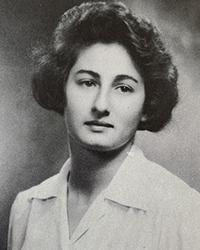
“We used an old moving-picture camera that could be driven manually. We had cardboard figures for our three characters and the room, and we placed them on a sheet of glass, on which the camera was focused from below…I would place a figure; Marianne would then make the exposure; I would move the figure to the next position; and so on.”4
It took them six hours to create the three-minute film, which has been used in countless demonstrations of apparent behavior ever since. Although Heider praised Marianne as one of the few students at Smith “who had any interest in the ideas that I was concerned with,”5 she recalled differently, confessing decades later that she hadn’t really understood the theoretical underpinnings of her undergraduate project. It was only later that she gained a deeper appreciation for Heider’s attribution theory. However, she always regarded him as an important mentor, who taught her “probably the most important thing any undergraduate could learn from a professor...how to follow a problem, to analyze it, to ask questions insistently, not to settle for the once-over quick answers.”6
Marianne jokingly claimed that informal interactions with the Heider family outside of the lab also afforded her a bonus education in cultural anthropology. “Grace [Heider] welcomed me into the Heider family, and at times, and with whatever reservations, entrusted the three boys to me. I learned much about life in the United States.”7 Marianne also befriended the family of Smith President Herbert Davis, who had arrived on campus the same year as she. As a native of England, Davis was keenly aware of the refugee crisis that Nazi Germany had created; his family hosted five young European refugees at the president’s house. Marianne referred to the Davis’s as her “adopted” family; they kept in touch through letter writing for decades.8
Internship: In 1943, the spring of her senior year, Marianne applied for a Psychology internship at Worcester State Hospital to study neuropsychology. Because she wasn’t yet a U.S. citizen, her application hit a snag, and Marianne only found out that she had been accepted weeks before the internship started. She worked with Chief Psychologist David Shakow, who would become a mentor and lifelong friend. “I was very young and green when I came to Worcester,” she recalled. “I had never seen a hospitalized psychotic patient. I got lost that first day, and was not able to leave a locked ward after the attendant had taken the keys from me. I always wondered whether that was part of the ‘educational plan.’”9
Graduate School: Marianne left Worcester after two years to begin graduate study at Harvard, where she received her M.A. in 1945 and her Ph.D. in 1948. Her doctoral thesis advisor was Eugenia Hanfmann, a Russian refugee who had arrived in the U.S. ten years earlier than Marianne to work as an assistant in Kurt Koffka’s laboratory at Smith. They would become close friends. Marianne’s doctoral thesis was entitled “A study of qualitative individual differences in thinking and problem solving.” To earn money while studying, she took adjunct lecturer jobs in several colleges nearby, including Cambridge Junior College and Wellesley.
Employment: Her first faculty position was at the College of Medicine at the University of Illinois in Chicago. She also served as assistant director of the Illinois State Psychopathic Institute. Around 1961, she joined the Psychology Department at Brandeis University, where she was reunited with friend and mentor, Eugenia Hanfmann. Marianne was a valued teacher. “She was demanding but also supportive, and the contacts she made with her students lasted long after their graduation, with Marianne always ready to intercede on their behalf.”10
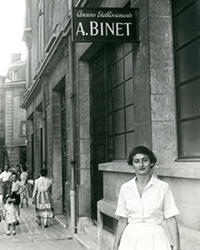
Professional Activities: In 1949, Smith awarded Marianne an Alumna Phi Beta Kappa. She was awarded diplomate status in clinical psychology from the American Board of Examiners in Professional Psychology; she was a fellow of five divisions of the American Psychological Association, including Society for the Psychology of Aesthetics, Creativity, and the Arts, for which she served as president in 1969–1970. In 2004, she received the Farnsworth Award from the latter society.
Overcoming Challenges: As a refugee who had fled Nazi Germany, Marianne struggled to feel secure in her adopted country. In her first year at Smith, she had applied to become a naturalized U.S. citizen; after the obligatory five-year waiting period, she was naturalized in 1945 while attending Harvard. Yet three years later, in a letter to David Shakow, she was still experiencing apprehension: “I am just developing a new type of paranoia: No matter what government, when and where—the government is always down on me.” 11
The Heider and Simmel Legacy: Early in her career, Marianne wrote to Heider to request a copy of the Heider-Simmel film for her own research. Her use of the possessive pronoun in the ask (“I would like to use our little movie with some of my [current] patients”12) denotes her sense of involvement in the project. The association was sometimes awkward, however. “Throughout my academic career, whenever I met a new colleague…the immediate reaction was always ‘you are the Simmel of Heider and Simmel,’ … often followed, perhaps a bit more hesitantly, by ‘but you didn’t stay in that kind of work.’”13 When supplying biographical information in later years, Marianne sometimes omitted the most famous research project of her career.
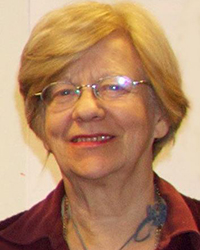
Footnotes
1 Thanks to Marianne’s brother, Dr. Arnold Simmel, for meeting to discuss Marianne and their early family life. Interviewed by Maryjane Wraga on August 1, 2022.
2 https://www.exploringsurreyspast.org.uk/hmd2019/ .Downloaded on 7/28/22.
3 Thanks to Leah Holden ’68 for retrieving information on Marianne from the History of American Psychology Archive.
4 [Box No. M6610-M6630, Correspondence Folder, Marianne Simmel papers], Archives of the History of American Psychology, The Cummings Center for the History of Psychology, The University of Akron.
5 Heider, F. (1983). The life of a psychologist. (p. 148). Lawrence, Kansas: University Press of Kansas.
6 Heider, F. (1983), p. 152.
7 [Box No. M6610-M6630, Correspondence Folder, Marianne Simmel papers], Archives of the History of American Psychology, The Cummings Center for the History of Psychology, The University of Akron.
8 [Box No. M6610-M6630, Correspondence Folder, Marianne Simmel papers], Archives of the History of American Psychology, The Cummings Center for the History of Psychology, The University of Akron.
9 [Box No. M6610-M6630, Correspondence Folder, Marianne Simmel papers], Archives of the History of American Psychology, The Cummings Center for the History of Psychology, The University of Akron.
10 [Box No. M6610-M6630, Correspondence Folder, Marianne Simmel papers], Archives of the History of American Psychology, The Cummings Center for the History of Psychology, The University of Akron.
11 Golumb, C. (2012). Marianne L. Simmel (1923-2010). American Psychologist, 67(2),162. [Box No. M6610-M6630, Correspondence Folder, Marianne Simmel papers], Archives of the History of American Psychology, The Cummings Center for the History of Psychology, The University of Akron.
12 [Box No. M6610-M6630, Correspondence Folder, Marianne Simmel papers], Archives of the History of American Psychology, The Cummings Center for the History of Psychology, The University of Akron.
13 [Box No. M6610-M6630, Correspondence Folder, Marianne Simmel papers], Archives of the History of American Psychology, The Cummings Center for the History of Psychology, The University of Akron.
Select References
Heider, F., & Simmel, M. (1944). An experimental study of apparent behavior. The American Journal of Psychology, 57, 243-259. https://doi.org/10.2307/1416950
Meyer, E., & Simmel, M. (1947). The psychological appraisal of children with neurological defects. The Journal of Abnormal and Social Psychology, 42(2), 193-205.
Simmel, M.L. (1953). The coin problem: A study in thinking. The American Journal of Psychology, 66, 229-241.
Simmel, M. (1956). On phantom limbs. A.M.A. Archives of Neurology and Psychiatry,75, 637-647.
Simmel, M. (1972). Notes on the creation of the perceptual object. Journal of Aesthetics & Art Criticism, 31(2), 193-200.
Anne Danielson Pick ’59
Developmental Psychologist and Dedicated Mentor
by Maryjane Wraga
Background: Anne grew up in the 1940s and 50s in Sycamore, Illinois. “It was a small town,” she recalls, “and it was in the era when girls were not encouraged to speak up much in school. Girls were not supposed to be brainy. If they were, they were not supposed to show it.”1

Psych Department Memories: Anne first considered majoring in sociology, but after taking an introductory course, she felt that the focus was too distant. “It gave me this image of somebody sitting on a platform up high watching all the little creatures on earth run around.” Psychology was a better fit for Anne’s wish to work with people; however, figuring out precisely how required further exploration. “One of the [Psych] courses I took was on the Rorschach [Test], with Professor Elsa Siipola. It convinced me that I did not want to do clinical psychology.”
In the 1950s, the Psychology department was housed in Pierce Hall.2 “There weren’t any labs,” Anne recalls. She settled on an honors thesis with faculty member Richard Teevan—a survey measuring “need for achievement,” where participants had to “interpret different scenarios or pictures.” The subject pool? Her classmates. Her “personal and intellectual” interactions with Teevan and also developmentalist Elinor Wardwell [later Ames] had the greatest impact on Anne during her time at Smith. They nurtured her interest in research and in the study of human development.
Graduate School: Like many seniors, Anne had “not a clue” as to what she wanted to do after graduation. She took the National Security Agency exam and scored well. However, she had a moment of enlightenment: “I do not want to spend my time breaking codes.” She applied to the Iowa Child Welfare Research Station and was accepted, but its name put her off. “You can see how carefully this was all thought out,” she recalls with a laugh. She applied to a Psychology PhD program at Johns Hopkins. The reply? “Thank you, but we don’t accept women.” It was Smith faculty member Elinor Wardwell who was the “conduit” to Anne’s future career. Wardwell was a Cornell PhD candidate teaching at Smith while she finished her dissertation. She telephoned her Cornell mentor Eleanor “Jackie” Gibson and told her about Anne’s interest in Psychology; Jackie encouraged Anne to apply.
Anne was accepted by Cornell, but despite having graduated from Smith with Honors, she was passed over for a prestigious teaching assistantship. Instead, she was awarded a research assistantship with Jackie Gibson. As the spouse of a Cornell faculty member,3 Jackie was prohibited from being on the faculty because of their nepotism rule; she had to settle for a research associate position. “Jackie was the low faculty on the totem pole, and she was given the low student on the totem pole as a research assistant...It was the best thing that ever happened to me,” recalls Anne with a smile. She and Jackie began a decades-long collaboration that would culminate in the 2002 classic book An Ecological Approach to Perceptual Learning and Development. Another plus? Jackie Gibson was a former Smithie from the class of 1931.
Marriage: While at Cornell, Anne met her husband, Herb Pick—another experimental psychologist. He was finishing up his PhD at Cornell as Anne arrived. “His parents hosted a big party for the four or five students who graduated that year, and I got invited.” He left for Russia on one of its first graduate student exchanges, but returned to Cornell the following summer. Their relationship deepened. Soon after, Herb left to begin his first job at the University of Wisconsin-Madison. Anne was able to join him after another year because of Cornell’s flexible residency requirements. They both would return to Cornell in summers while she finished her degree.
Employment: After obtaining her PhD in 1963, Anne landed a teaching position at Macalester College. She was also part of a research grant through the Institute of Child Development (ICD) at the University Minnesota, where Herb was now on the faculty. Anne was eventually offered a job there as well. It wasn’t a difficult decision to make. “I loved teaching, but I also wanted to do research.” She and Herb remained at the ICD throughout their careers and until his passing in 2012. Along the way, they took advantage of opportunities for sabbatical leaves at Makerere University in Kampala, Uganda, and at Katholieke Universiteit in Nijmegen, Netherlands.
Research: Anne has conducted research with such distinguished collaborators as James and Jackie Gibson, as well as her spouse, Herb Pick. Her studies have focused on perceptual learning in both children and adults. One early study, conducted with James Gibson, examined the precision with which a person can tell if someone is looking at them. “[James] would claim that one can tell if one is being looked at; Anne conducted a study with him that provided the empirical evidence. “You can perceive that you're being looked at, even when the person looking at you has their head turned. The joint eye-head position provides the information.”
Anne studied a related phenomenon in infants—joint attention, the ability to coordinate their gaze with that of a caregiver toward the same object. It plays a critical role in cognitive development. “My graduate students and I were interested in the degree to which you can direct an infant's gaze to an object or event before they can use pointing. Once the adult and the infant are jointly engaged in looking at something, it provides enormous motivation for communication and scaffolds all kinds of learning.”
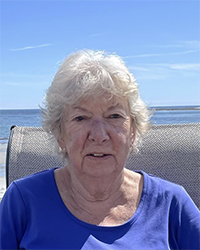
Anne had a five-year run editing the sixth to tenth volumes of the prestigious series Minnesota Symposia on Child Psychology (1972 - 1976), the goal of which was to represent “cutting-edge work in the field.” Reviewers praised her for putting together an “outstanding” collection of contributions and for “maintaining the high standard”4 set in earlier volumes of the series.
Distinguished Award: Anne is also well known for her dedication to mentoring undergraduates at the ICD. To honor this achievement, the ICD established the Anne Pick Award for an Outstanding Child Psychology Major, given annually to one undergraduate child psychology major.
Overcoming Challenges: It was difficult to be a woman with three young children while on the tenure clock. “It required a lot of juggling. Herb and I would cover for each other. I had a 75%-time appointment for many years. And we had a wonderful ‘Grandma Black’ who helped out every day. I would be in the department from 10 to 4. At some point I realized that my [full-time male] colleagues were working at home one or more days a week. Their students were coming to my office while they stayed home.” Anne was able to petition successfully for full-time employment.
Advice for Students Pursuing a Career in Psychology: Anne offers a simple adage that reflects the success of her own research career: “Do what you want to do!”
Footnotes
1 Unless otherwise indicated, all quoted material is from an interview with Maryjane Wraga on August 18, 2022.
2 In 1964, the department moved to more spacious accommodations on two floors of Burton Hall as part of a consolidation of the Science Center. In the early 1990s, Psychology moved to its current home of Bass Hall.
3 Jackie Gibson ’31 was married to James Gibson. Both were professors at Smith before leaving for Cornell in 1949.
4 Lipsitt, L.P. (1977). From a classic series. Contemporary Psychology, 22(8), 586-588.
Select References
Flom, R., Barrick. L.E., & Pick, A.D. (2018). Infants discriminate the affective expressions of their peers: The roles of age and familiarization time. Infancy, 23(5), 692-707.
Gibson, E. J., & Pick, A.D. (2000). An ecological approach to perceptual learning and development. New York: Oxford University Press.
Smitsman, A. W., van Loosbroek, E., & Pick, A. D., (1987). The primacy of affordances in categorization by children. British Journal of Develomental Psychology, 5, 265-273.
Soken, N., & Pick. A.D. (1992). Intermodal perception of happy and angry expressive behaviors by 7-month-old infants. Child Development, 63, 787-795.
Ziemer, C.J., Plumert, J.M., & Pick, A.D. (2012). To grasp or not to grasp: Infants’ actions toward objects and pictures. Infancy, 17, 479-497.
Lynn Hasher ’66
Paying Attention to Things of Value
by Maryjane Wraga
Background: Lynn grew up in the Bronx, New York, until the sixth grade (1950s), when her family moved to Levittown, Pennsylvania. She has two younger sisters.
Early Influences: Lynn’s education in the New York City schools put her two years ahead of the Falls Township curriculum. Her teacher there had “no clue what to do with me.”1 The solution was to have Lynn tutor a woman with serious intellectual and physical challenges. The patient had anterograde amnesia—the inability to form new long-term memories—although Lynn obviously wasn’t aware of this diagnosis at the time. “I would sit with Claire and teach her something, and by the end of the session she seemed to understand. But the next day she couldn’t remember what we had done. I was fascinated by how that could possibly be.” This experience would stay with Lynn for years.
Lynn was also an avid reader, devouring “whatever was available in the Levittown Public Library,” and before that, the small local branch of the New York Public Library. Her parents were “adamant that [Lynn and her sisters] would go to college,” and they lived “very frugally” so there would be enough money for all three to go. “I never really considered not going to college.”
Why Smith? Lynn’s journey to Smith started with an announcement on the bulletin board outside her high school guidance counselor’s office, featuring a picture of Capen House. The posting advertised a scholarship to Smith, available for “a person from the Philadelphia area who walked on water.” Lynn was motivated to apply: “My sisters were coming up behind me.” Her guidance counselor also advised that scholarships to all-women colleges would be easier to obtain than those for coed schools. Lynn applied and got the scholarship, “despite not matching all of those qualities,” she is quick to add. When two alums from the local Smith club visited her home for a final interview, Lynn’s mother sealed the deal by putting out “all of her cracked dishes” to ensure that the College understood Lynn’s financial need.

Despite the changing times, the majority of Smith students in the early 1960s seemed relatively conservative. By her senior year, Lynn had become more politically active. While in charge of some house activities, she invited an SDS (Students for Democratic Society) group from Wesleyan to come and talk. “My housemates were horrified by these people.”
Psych Department Memories: Lynn initially gravitated to Religious Studies, but her parents advised her to major in something more practical/employable. Lynn had taken Intro Psych and enjoyed “the experimental side, the analytic aspect of it.” She remembers the home of the Psychology Department—Pierce Hall—as having “a few small rooms” for conducting studies, one of which was used by recent hire Bob Teghtsoonian. She remembers exiting Pierce Hall one evening when several faculty members were outside demonstrating techniques for viewing the moon illusion.2
An Experimental Psychology course on Human Learning that Lynn took with faculty member Barbara Musgrave set her on a new path. At the time, research on nonhuman animals dominated the field; the 500-page textbook for Musgrave’s course had “maybe fifty pages” on human learning and memory.3 What little human research was out there involved iterations of one experimental procedure—memorizing lists of nonsense syllables. “The idea was that you could understand the acquisition of knowledge by studying these little building blocks.” Musgrave and fellow faculty member, Jean Cohen, disagreed. “They wrote a paper on the importance of using real-world materials rather than nonsense syllables. Other [memory and learning] researchers pooh-poohed it.” The importance of ecological validity in empirical research is now widely acknowledged. “[Musgrave and Cohen] were at least fifteen years ahead of their time.” The course reignited Lynn’s interest in human memory. She did an honors thesis with Musgrave titled “The Effect of Overtraining on Abstraction in Verbal-Associate Learning.”
Graduate School: Lynn knew she wanted to pursue memory studies in grad school. She turned to Barbara Musgrave for advice; Musgrave steered her to the best people in the field. “I applied to Stanford, Northwestern, Berkeley, and Harvard without any knowledge of how difficult it would be to get in. The person at Stanford had decided that he was going to be a clinical psychologist because he was tired of nonsense syllables, so he wasn't taking any students. I didn't get into Harvard; I might have been waitlisted. The person at Northwestern had had a terrible experience with a woman graduate student and swore he would never take another.” Luckily, Leo Postman at Stanford viewed women graduate students favorably, and he perceived graduates of a women’s colleges as having a particular advantage. “Postman believed that we could all write well, and that mattered to him greatly. Hence my admission.”
Lynn found the cultural changes occurring between 1966 and 1970—her time as a PhD student at Berkeley—to be even greater than what she had experienced as a Smith undergrad. “The Vietnam war was on, and because I had grown up in a working-class neighborhood, I knew boys who were drafted or who volunteered. I got letters from a few of them in Vietnam. I was really much more shaken by that.”
There were also student protests on Berkeley’s campus. “I lived on the edge of People's Park. I was there when the riot occurred, and a student was killed. There were several times when I could not go home because the Psychology building was on the north side of the campus, and I lived on the south side. The tear gas was on the south side.” On such occasions, Lynn would stay with a fellow Smithie (working on her PhD in history) in Oakland.
The tension on campus continued. “One day I went out of my apartment to go running and I got to the corner, just off of Telegraph Avenue, the main drag for students. There were four military guys with bayonets sticking up from their rifles. So I crawled back home. It was the creepiest thing I had seen to that point in my life.”
Amidst all the chaos, Lynn worked as a part-time research assistant for Postman for twenty hours a week, all the way through her last year of graduate school. In her spare time, Lynn did “various whack- a-doodle experiments,” none of which actually worked. For example, in one study she presented incomplete sets of related items to participants, and memory for that information was tested (e.g., summer, winter, spring; knife, spoon). The research question was whether the missing counterparts [e.g., “fall” or “fork”] would be recalled. “I found no such evidence! I've always been interested in experimental topics that are off the beaten track.” Lynn was not daunted by these disappointments. “My publications as a grad student were on projects I had helped collect data for,” such as a recognition task on which kindergarteners and college students did equally well. She graduated with a Ph.D. in Psychology in 1970.
Employment: Lynn stayed at Berkeley for another year before hitting the job market because she was “always interested in individual differences, and always believed that testing college students only was a serious mistake.” She did a postdoc in developmental psychology to broaden her research experience.
Her first job was at Carlton University in Ottawa, Canada, where she encountered “rampant sexism” as well as racism—by English speakers against French speakers.” In addition, there was much anti-American sentiment because of the U.S. involvement in the Vietnam war. “It was a very uncomfortable year.”
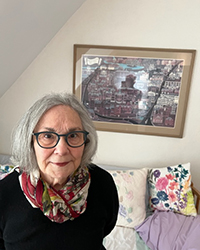
Research: Throughout her long career, Lynn has published over 200 empirical articles on attentional processes and how they affect other cognitive abilities, such as memory and language. She has also studied these effects in the elderly and across cultures. A few of her lines of research are highlighted here.
In 1977 Lynn published research with her spouse, David Goldstein, and colleague Thomas Toppino, on what’s now called the illusory truth effect. “The idea was that knowledge accumulates automatically via fundamental building blocks such as frequency, rather than mere associations.” They found that peoples’ ratings of the veracity of a list of statements were influenced by prior exposure to the statements, regardless of statement accuracy. In other words, the more we hear a fact—regardless of whether it’s true or not—the more likely we will perceive it as true. Lynn and colleagues were so concerned about the potential misuse of the findings outside academia that they intentionally gave the article an ambiguous title: “Frequency and the conference of referential validity.” Ten years or so later, another research group replicated the findings, and more studies ensued. The phenomenon was eventually renamed the illusory truth effect.
Lynn was studying attention at a time when male researchers dominated the field. With the exception of the work of Anne Treisman, women faced an uphill battle in gaining recognition. To illustrate this point, Lynn describes a conference on Attention and Performance she was invited to attend in Israel decades ago. She recalls being one of only a few women invited. “There was a group photo taken at the end, which was supposed to be of speakers only. The male graduate students maneuvered themselves into the photo, and the female graduate students were scooted away. It was representative of the world [of attention researchers] at that time.”
By happy accident, Lynn found a successful workaround. She had first met Rose Zacks4 when they were both grad students at Berkeley. Their friendship became the basis of a formidable collaboration on attention and working memory. One of their most important studies5 revealed how inhibitory control—a person’s ability to keep unwanted thoughts or other distractions in check—impacted subsequent working memory performance: The lower the inhibitory control, the worse the working memory performance, and vice versa. It was a noteworthy finding because working memory underlies many other cognitive functions such as learning and verbal comprehension.
Lynn and colleagues have also studied the connection between sleep cycle, attention, and emotion. “One finding was that older adults are generally in better moods than young adults” and also tend to fall into the category of morning person. The next step was to tease out attention performance. “We found that when people are in better mood, they tend to have a broader focus of attention.” For older adults, this translates into an emotional advantage to being a morning person. A follow-up study using functional magnetic imaging (fMRI) revealed that neural activation of attention areas in the brains of older adults approached that of younger adults in the morning, but not in the afternoon. “We concluded that researchers need to take into account whether they are testing morning-type or evening-type people because the behavior of those two groups is really quite different across the day.” They also pointed out that older adults’ cognitive functioning was often underestimated because they were not tested in the morning.
Awards and Honors: Throughout her career, Lynn has received many accolades for her work. Highlights include a James McKeen Cattell Fellowship, and a fellowship from the John Simon Guggenheim Memorial Foundation. She’s served as a member of the Board of Governors for the Psychonomic Society, and also served as chair. She’s received the Distinguished Professional Contribution to Knowledge Award from the APA and a Merit Award from the NIH.
She received a Senior Mentor Award from Women in Cognitive Science in 2012.
Greatest Achievement: “The two big papers: one on automatic and effortful processes, and the other on inhibitory control. I would say those are my proudest achievements.”
Overcoming Challenges: “Marry the right person, one who supports your career and allows you to work. For example, the inhibitory control paper was an idea that got developed in the last five weeks of my Guggenheim award, and I worked about twenty hours a day for those four or five weeks. My husband took care of the kids and the food and the laundry, and everything.”
Advice to Students Pursuing a Career in Research Psychology: “Go to the best possible graduate program you can get in to, publish as much as you can, and network like crazy, even as a graduate student. Walk up to a famous researcher [at a conference] and just start talking to them. Also, have a good social media presence, such as a fabulous website.”
Footnotes
1 Unless otherwise noted, all quoted material is from an interview conducted with Maryjane Wraga on November 8, 2022.
2 Students have studied the moon illusion in the Smith Psychology department since at least 1909, when faculty member Arthur H. Pierce (for whom Pierce Hall is named) sent students outdoors to make comparative size judgments of the horizon versus zenith moon and record the data. In Fall 2022, we continued the tradition using Pierce’s original worksheet.
3 The textbook was Kimble’s revision of Hilgard and Marquis’s Conditioning and Learning.
4 Rose Zacks is currently Professor Emeritus of Cognition and Cognitive Neuroscience at Michigan State University.
5 See Reference #5, below.
Select References
Amer, T., Wynn, J.S., & Hasher, L., (2022). Cluttered memory representations shape cognition in old age. Trends in Cognitive Sciences, 26, 255-267.
Weeks, J.C., Grady, C.L., Hasher, L., & Buchsbaum, B. (2020). Holding on to the past: Older adults show lingering neural activation of no longer relevant items in working memory. Journal of Cognitive Neuroscience, 32, 1946-1962.
Amer, T., Campbell, K.L., & Hasher, L. (2016). Cognitive control as a double-edged sword. Trends in Cognitive Sciences, 20,905-915. 10.1016/j.tics.2016.10.002 (December)
Hasher, L., Zacks, R.T., & May, C.P. (1999). Inhibitory control, circadian arousal, and age. In D. Gopher and A. Koriat (Eds.), Attention & Performance, XVII, Cognitive Regulation of Performance: Interaction of Theory and Application. (pp. 653-675). MIT Press.
Hasher, L., Goldstein, D., & Toppino, T. (1977). Frequency and the conference of referential validity. Journal of Verbal Learning and Verbal Behavior, 16, 107-112.
Susan Goldin-Meadow ’71
The JYA Experience that Launched a Career
by Maryjane Wraga
Background: Susan was born in New York City, but grew up in Hillsdale, New Jersey in the 1950s and 60s, after moving there as a toddler. Her father was an accountant who commuted to the City: her mother taught high school in Rockland County, New York.
Early Influences: “My New York (Jewish) folks definitely wanted me to go to college and wanted me to aim high.”1

Smith Brain Drain: The late 1960s was a time of political and social upheaval. One issue felt keenly at Smith was the transition of all-male Ivy League schools to a coed model. “There was a lot of kvetching on campus during my sophomore year. All the schools were trying to decide: Should we go co-ed or not go co-ed? There was angst in the air. My close friend from Hillsdale, who had come to Smith with me, transferred to Yale for her junior year, and then graduated from Yale. A chunk of Yale’s first co-ed class came from our ranks.”
Memories of the Psychology Department: Susan wasn’t enthralled with the psychology major at first. “I decided to do psychology more out of a process of elimination than by anything else. I wasn't all that fired up about it.” She recalls taking a lab course with faculty member Mimi Teghtsoonian, “where we studied reinforcement in rats and children. It was a very behaviorist time in psychology.” Things changed when Susan studied abroad in Geneva, Switzerland during her junior year, a decision driven by twin desires of improving her high school French and escaping the co-ed anguish on campus.
JYA at University of Geneva: The Smith psychology department approved of Susan’s JYA plan but said that she had to take all of her psych courses at Smith before or after the year abroad. Instead, she decided to also take Psych courses while at Geneva—a decision that altered her career path. The University of Geneva was the home institution of pioneering developmental psychologist Jean Piaget. “I didn’t really know anything about [Piaget’s] psychology,” she admits. In addition to taking courses with Piaget and his colleague Bärbel Inhelder, she joined the research team of Hermina “Mimi” Sinclair, a developmental psycholinguist affiliated with Piaget. Another young woman on the team was Annette Karmiloff from England. “She and I started to work together with Sinclair on a project on the acquisition of relative clauses. Annette and I didn't like the way the project was going so we went rogue and did it our own way, using a simpler design. That research experience really inspired me. It was my first time doing independent research, and I loved it.”2
Professor Piaget: What was it like to take courses from Jean Piaget? He spoke in “slow and complex sentences. He taught Mechanisms of Perception that year, which was his new book. [In the European manner of teaching], he basically read the book. I struggled at first because my French wasn't great.”
Senior Year: After returning to the U.S., things felt different. Susan had missed some pivotal cultural moments such as the Kent State Massacre and the first walk on the moon: “We had to read about them in the papers.” Campus life had settled down. Perhaps students were distracted by new freedoms: They were given keys to the front doors of their houses, curfews were abolished, and boys were allowed in the rooms for greater periods of time. Susan’s passion for psychological research had not waned. She signed up for an honors thesis with Mimi Teghtsoonian, which consisted of a follow-up study to the project she had begun with Karmiloff in Geneva. “It was exciting to do my own stuff. I knew I wanted to go on to graduate school.”
Graduate School: Susan’s boyfriend, William Meadow, had graduated from Amherst College the previous spring and started medical school at the University of Pennsylvania. “I wanted to be with him, but I didn't want to sacrifice my career. I asked for advice about where I should study language acquisition. I asked my Physiological Psych professor, Fran Volkmann. She had no idea: she did physiological psychology! However, she'd gone to Brown, and one of the students there was Harris Savin, a really smart person who did language acquisition and was now at Penn. That's all I needed to hear! I applied to other the places around that area, but I really wanted to go to Penn.”
U Penn turned out to be the perfect place for Susan. Her advisers were Rochel Gelman and Lila Gleitman, who, like many professors there, encouraged student collaborations. Susan connected with Heidi Feldman, another student who shared an interest in language. They began brainstorming about research projects. After “lots of trials and tribulations,” they decided to study informal communicative gestures (“home signs”) produced by deaf kids of hearing parents who were not exposed to formal sign language and couldn’t learn spoken language. Initially their advisers worried: “What happens if [you] find that the deaf kids invent nothing? It's hard to get even one dissertation out of that; How will [you] get two?” They decided to go for it anyway. “I took the syntax. Heidi took the lexicon.” They studied six children in the Philadelphia area, most of whom required repeat visits. On each occasion they carried “a video box, a huge camera, and a TV monitor plus all the toys. We schlepped it all over to North Philly; it was a little crazy.” The project was a success. And to this day, Susan remains friendly with the family of one of the “children” (now in his 40s).
Employment: Susan and William married in 1971, and both found jobs in Chicago. Susan started at the University of Chicago in January 1976 and has been there ever since. She is currently the Beardsley Ruml Distinguished Service Professor in Psychology and Comparative Human Development. She has received the Burlington Northern Faculty Achievement Award for Graduate Teaching and the Llewellyn John and Harriet Manchester Quantrell Award for Excellence in Undergraduate Teaching. She also received a mentor award from the American Psychological Association.
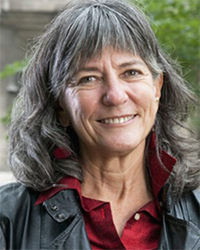
Awards: Susan has received many accolades for her research, including a Guggenheim Fellowship and a James McKeen Cattell Fellowship. She was elected to the American Academy of Arts and Sciences, and recently to the National Academy of Sciences. She also won the David E. Rumelhart Prize for Contributions to the Theoretical Foundations of Human Cognition, and the William James Award for Lifetime Achievement in Basic Research. University of Geneva—her JYA academic home—recently awarded her with an honorary doctoral degree.
Overcoming Challenges: At Chicago, Susan experienced difficulties from a senior faculty member early on. “She had encouraged me to apply, and when I arrived, she expected me to be her assistant in some way. I didn’t want to, so I didn't. She got really annoyed and made my life pretty miserable for some time.” Susan decided to apply for jobs elsewhere; she received an offer of promotion and tenure at a different institution. At the same time, Chicago brought her up for tenure; however, because of negativity from the senior faculty member, Susan was offered only promotion. Her husband couldn’t find a job at the other institution, so Susan decided to stay put. “It was so difficult to turn down the tenure job, [especially as] I was pregnant with our first child at the time.” But things worked out. Another faculty member stood up for Susan, and the disparaging senior faculty member backed off, even apologizing many years later, which Susan noted as “both wonderful and terrible at the same time.” Susan’s career and her husband’s career continued to flourish. The hard choice of weathering the storm at Chicago turned out to be the correct decision.
Advice for Students Pursuing a Career in Psychology: “Figure out what topic you really like thinking about and what you want to know about it. There are so many boring theories in Psychology; figuring out whether they're correct or incorrect may not be an optimal pursuit. I'm a phenomenon person; I like looking at the world and seeing what's really interesting about it, particularly for psychology, and then figuring out what we can say about it as psychologists. If you go to grad school, try to choose the one where you're given some flexibility. Try to find a professor you really hit it off with, and try to create things together.”
Parting Thoughts: “Smith turned out to be great — I found a career that I was passionate about, along with a husband from Amherst who was the best partner and father I could possibly imagine,3 and I made many life-long friends. It turned out to be the ideal school for me.”
Footnotes
1 All quoted text is from a Zoom interview with Maryjane Wraga on July 25, 2022.
2 Annette Karmiloff-Smith would also go on to become a prominent developmental researcher. At the end of their year in Geneva, they each wrote up the project for their respective programs. Although they remained life-long friends, they never published anything together. Karmiloff-Smith passed away in 2016. “When I visited her at the end, I said ‘we did good work when we were kids,’ and she said ‘we should have published it.’” For Karmiloff-Smith’s festschrift, Susan wrote up the research with Annette as posthumous co-author.
3 It is sad to note that William Meadow died in 2019.
Selective References
Goldin-Meadow, S. (2020). Discovering the biases children bring to language learning, Child Development Perspectives, 1-7.
Goldin-Meadow, S. (2020) Approaching learning hands first: How gesture influences thought. In: Dess, N. K. (Ed.), A Multidisciplinary Approach to Embodiment (pp. 46-50). Routledge.
Goldin-Meadow, S. (2020). Using gesture to identify and address early concerns about language and pragmatics. Pediatrics, 146(Supplement 3), S278-S283.
Demir-Lira, O.E., Asaridou, S., Beharelle, A.R., Holt, A., Goldin-Meadow, S., & Small, S. (2018). Functional neuroanatomy of gesture-speech integration in children varies with individual differences in gesture processing. Developmental Science, 21(5), DOI:10.1111/desc.12648.
Goldin-Meadow, S., Levine, S.C., Hedges, L. V., Huttenlocher, J., Raudenbush, S., & Small, S. New evidence about language and cognitive development based on a longitudinal study: Hypotheses for intervention, American Psychologist, 2014, 69(6), 588-599. doi:10.1037/a0036886.
Ann Masten ’73
The Road to Resilience Research Is
Paved with Many Mentors
by Maryjane Wraga
Background: Ann was born in Georgia—the oldest of four siblings—but lived in many different places during her childhood in the 1950s and 60s because her father was in the military. Both of her parents came from Southern farming families.
Early Influences: Many in Ann’s family—her parents, grandmother, aunts, and uncles—were big proponents of education. “They were my anchors. I can remember my grandmother saying that the one thing nobody can ever take away from you is your education.”1 Her family had a lasting influence on her education. “I‘m one of those people who loved school from the very beginning. I loved kindergarten!”
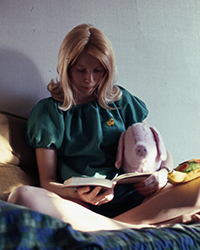
On Campus: Ann attended Smith from 1969-1973, a time of unprecedented cultural change, including increased protest against the Vietnam War. In May 1970, the end of Ann’s first year, the American public learned that President Nixon had secretly expanded involvement in the war. Campus protests—from students and faculty alike—broke out all over the country. Now known as the Student Antiwar Strikes,2 these actions protested both the war itself and the infamous Kent State shootings of student protesters that occurred shortly thereafter. Some student protesters even demanded—and were granted—the elimination of final exams that semester. Ann found herself in a dilemma. Her father had been deployed to Vietnam while she was in high school. “It was a challenging experience to have people protesting war all around me. No matter what I felt about the war, I couldn't join the protests knowing what military families endured.”
The feminist revolution was also coming into its own. “It was an eye-opener for me. There was a tremendous amount of energy around the idea that women could be whatever they wanted to be. People knew it wasn't going to be easy, but there was a lot of support for what women could accomplish. “I was affected by the overall atmosphere of support.” It was a fantastic time. “Clothes were changing, music was changing. It was a time of seeking change overall—personal change as well as change in the country. I was caught up in that.”
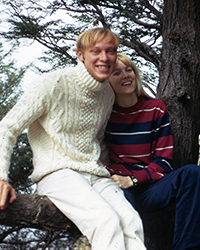
Psych Department Memories: “I started off majoring in English because I didn't know what I wanted to do. I’d had a wonderful English teacher in high school who encouraged me to consider an English major because I love literature.” Ann enjoyed the literature classes she took at Smith, but “gradually realized that what I really liked about literature was the psychology of it. I thought, Wow! I’m in the wrong discipline here.” At the time of this realization, she had already fulfilled the English major requirements. She added Psychology as a double major.
“I never did an honors program because I didn't have time. I squished [the Psych requirements] into a short period.” This included taking some of the introductory-level courses at UMass over the summer, so she could take meatier classes at Smith in her senior year. She also managed to volunteer at the Northampton State Hospital, “a really scary place” that nevertheless provided valuable experience. A “profoundly important influence” was taking two advanced seminars from Elsa Siipola.3 “I loved the high-level, intellectual atmosphere of her seminars.” Siipola was a “real character” who had her students over for dinner at her home. She was also “extremely encouraging.” She would say, “Well, of course you want to go to graduate school,” even though it had “never even dawned on” Ann to do so. Siipola’s praise was sincere. “One day in the spring of my senior year, she asked me, what would you think about a job in the DC area? There's a position I think you would really like.” It was a research assistantship with legendary clinical psychologist David Shakow—architect of the Scientist-Practitioner Model of training—at the National Institute of Mental Health (NIMH) in Bethesda, MD.
Post-Smith: Ann met with Shakow and got the job. “We hit it off right away.” She moved to DC along with her husband Steve. He had applied to law school and got into Georgetown, another “lucky coincidence.”
She worked at the NIMH for three years, an education in itself. When she started, Ann “barely knew what clinical psychology was. I knew it had something to do with helping people with problems.” By the end, after immersion in cutting-edge research in the field, she “actually knew what clinical psychology was” and set her sights on a PhD.
Ann’s work with Shakow left time to explore. He was in his seventies and “already an emeritus scientist” who worked part time. “He encouraged me to do whatever I wanted at NIMH. I arrived there during this incredible blossoming of research. They had started to image the human brain. I volunteered to help out with research. I went to conferences.” The favorite talk she attended was titled “The gain in brain is mainly in the stain,” a reference to anatomical tracers in early positron emission tomography (PET) scans. “I met a lot of interesting researchers, both in developmental [psychology] and in psychiatry—people who were leading new work on child development and mental health.”
Shakow had “many friends, and he was like a walking history book.” Researchers and journalists would come to see him. Ann met “many, many prominent psychologists and psychiatrists” this way. Most of the visitors ignored “the gopher [i.e., Ann] sitting in the room.” One exception was Norman Garmezy from the University of Minnesota. “He visited frequently and took an interest in me and what I was doing.” He would eventually become her third mentor. “The mentoring trail went from Elsa Siipola to David Shakow, to Norman Garmezy, all through personal connections.”
Graduate School: Ann applied to several schools, but she was set on working with Garmezy. An article about his work on resilience (then called “stress resistance”) had come out while she was deliberating. The topic appealed to Ann for two reasons. “Growing up in the military, you observe a lot of your friends adapting to adversity, either by moving around a lot or dealing with the fears of a deployed parent being injured or dying. Another influence stemmed from Ann’s seminars with Elsa Siipola at Smith. “I was intrigued by theories about competence in development. I even wrote a paper about Robert White’s theory of competence for one of [Siipola’s] seminars. That interest dovetailed beautifully with the work that Garmezy was doing in his research group, which was called Project Competence.”
She accepted an offer from the University of Minnesota to work with Garmezy as a PhD student in Fall 1976. “He was beginning a new line of work. I arrived right when an important new study was beginning, and helped to shape it.” Ann found Minnesota to be “an incredible place for training in clinical psychology. She was influenced by close relationships with “wonderful peers and faculty” at Minnesota, which had an “outstanding psych department.” Ann cites Auke Tellegen, Paul Meehl, and Irv Gottesman as professors in Psychology who had a major influence, along with a more advanced fellow student, Dante Cicchetti. “Dante was always encouraging students to go into science careers because a PhD in clinical psychology offers multiple career pathways. You can go in a more clinical direction or toward research. Dante was instrumental in founding developmental psychopathology.” At conferences, she also met “a cadre of international researchers who were the vanguard of resilience science and its translational applications. They co-mentored each other's students.”
Minnesota was also “an incredible place for training in developmental science. Garmezy encouraged that; he felt that scholars who wanted to understand development should take courses from folks down the street in the Institute of Child Development (ICD). As a result, I was influenced by Alan Sroufe, Bill Hartup, and other amazing developmental scholars.” The ICD hosted the Minnesota Symposium every two years as well, where leading scholars presented “exciting research.”
Garmezy was also involved in “organizations like the American Psychological Association, among others, and he also had close relationships with other leaders in resilience science, including Michael Rutter, Arnold Sameroff, and Emmy Werner. Their ideas influenced me as well because Garmezy respected them and they were supportive.” Ann summarizes her graduate experience: “All those interactions created a learning situation where not just me, but other students of that era flourished.”
Before completing her PhD in 1982, Ann went to UCLA for a full-time clinical internship. By then, she and her husband had had their first child. “My husband took the year off and took care of our daughter, so I could really focus on this year of clinical training.” The family then returned to Minnesota and Ann obtained grant funding to continue working with Garmezy as a post-doctoral fellow for a few years, having another child during that time.
Employment: “When I went on the job market, it turned out that the best job was just a block away.” Ann accepted an assistant professorship in the University of Minnesota’s Institute of Child Development. The search committee was chaired by Smith alum Anne Pick.4 “I still remember Anne running over to congratulate me with a hug when she heard I was accepting the position. Ann has never looked back. “I realized that I wanted to deepen my developmental side. I still maintain a clinical license, but I became more well known as a developmental scientist.” Her current title is Regents Professor of Child Development.
Research: The majority of Ann’s research has focused on the science of resilience. “We are trying to figure out pathways to resilience in development: How is it that some people come out of a lot of adversity and do well; whereas, others—sometimes in the same family—develop all kinds of problems?”
One of the populations she’s best known for studying resilience in is homeless children. “I was doing some volunteer clinical work for a child guidance clinic in the Twin Cities. The leadership there were very concerned about homelessness.” It was the 1980s, and many cities were experiencing a housing crisis. “The clinic asked if I would go to shelters to get a sense of what was going on, and find out what I could from the literature.” Ann began visiting shelters and soon realized that there was a “serious need for more information about children” specifically. At the same time, shelter providers expressed interest in data that could inform their programming, particularly for low-income families. Ann decided that this was a “worthwhile direction” for her research. “I carried out my first study of homeless families in 1989. Students were eager to help out.” Ann developed relationships with shelter providers and school district personnel trying to help homeless children—a legacy of her mentor, Norman Garmezy, who taught her the importance of establishing long-term collaborative relationships. She began reporting her findings to these providers. Ann was eventually able to set up a working lab within the shelters. “I've continued to do work with these families.” Thirty years later, “a lot of my local research in the Twin cities continues to be focused on families experiencing housing disruptions and extreme poverty.”
“I've always had an interest in doing research that could make a difference. My research was community based at a time when that wasn't nearly as popular as it is now. [My students and I] learned a lot just by going and listening. The families and shelter providers we've worked with over the years have taught us a lot. I think they always knew that we were trying to do the best we could to find out what would make a difference” for homeless kids.
The findings were surprisingly straightforward. “We found out that children who are doing well, despite incredible adversity, often have parents who are showing their own resilience. The parents may be struggling with a lot of painful adversity, but they're still focused on getting their kids to school and trying to find support so their kids can make it.”
Ann’s research led to what she would later call “the short list of the most powerful human resilience factors,” such as good parenting and social support; self-control skills; hope and optimism; a sense of belonging and meaning; and positive routines or celebrations, whether these protective influences come from families, shelters, schools, and teachers; or cultural practices, religion, and spirituality. “Over the years we've learned a lot about what kinds of adversity are most harmful, and what kinds of protections make a big difference. Some of the most powerful protections for children are relationships with competent and caring adults, in the family and beyond.”
Ann and her colleagues applied what they learned about resilience to work with Cambodian survivors of Pol Pot—Khmer-American youth resettled in Minnesota. “They were refugees, but I could see a lot of the same protective influences in their lives. The adversity was different but the protections after displacement were similar.” One major difference had to do with cultural practices. The Khmer Rouge had systematically attempted to destroy the culture of the Cambodian people. “They didn't want young people to have education or to practice their faith, their dances, or any of their other traditions. It was fascinating to watch the Cambodian refugees regroup and re-establish their cultural traditions. The adults did it for their kids, who learned language and songs and dances and food traditions, and so forth. That had a powerful effect on recovery.”
When asked about instances when children of any culture have no access to resources or caring adults, Ann is sanguine. “I've certainly seen dire situations. Some are very heartbreaking. Things do not go well, and kids end up going down a very dark path. But I've also seen late bloomers, kids who kind of zigzag. They go off track because there’s so much burden and lack of support, and then they find their way back. It’s often through relationships with mentors and caring people again. In adolescents, brain development also helps; eventually it is on their side, improving judgment and planning. Our society also tries to help kids get back on track. Some of the opportunities we offer are military service, college or technical training, and apprenticeships. Those all can be positive. And some young people find positive support through faith that transforms them. The big takeaway from research on risk and resilience is that a lot of the protection kids need comes from the world around them as well as the inside. It's not all about personality or individual traits. It's about support from the outside. We have to keep opening doorways and providing support to give kids an opportunity to get back on a positive path.”
Ann wrote a book on the topic that came out in 2014 called Ordinary Magic: Resilience and Development. She included the phrase “ordinary magic” to refer to “fundamental adaptive systems that are the big engines of resilience in human lives and part of our human legacy. Research reveals that resilience in adversity depends on surprisingly ordinary but powerful capabilities and relationships that provided people dealing with adversity the capacity to mobilize adaptive responses. Ordinary magic stems in large part from the short list of resilience factors [mentioned above], which begin to emerge in very young children and continue to develop and change throughout life. They have evolved and persisted in our biology and cultures over many generations because they help us deal with adversity. And because humans are profoundly social, we can see the same resilience factors at work, not just in the lives of individuals, but also in organizations, communities, and societies. Schools and cities are now asking how we can nurture resilience, particularly in children and youth. What we've learned about resilience really applies at multiple system levels. And one of the reasons that human beings are so adaptive is because we can connect with each other and create much greater capacity to respond to adversity working together through our interconnected systems.”

Greatest Achievement: “My students. Certainly, the ideas that I've developed and disseminated on resilience are important to me. But the true legacy of your work is the students who carry on with your research.” To this end, Ann received the APA mentoring award in 2022.
Overcoming Challenges: “Clearly the biggest challenge is work-life balance—trying to balance having a very demanding kind of career if you're in a research university, with being a good mother, wife, and daughter. It’s trying to balance all the other family things that you're trying to do. I'm sure my family would say that it doesn't always work. It's very difficult.”
Advice to Students Pursuing a Career in Research Psychology: “There's no substitute for research experience; that keeps all doors open. But it's also important to get experience on the ground. I always want [my students] to volunteer in the context in which we're going to be doing research, so they can really understand who the people are, what their experiences are like. Over the years, I've done a lot of research on families experiencing homelessness. My students and I have done a lot of volunteering at homeless shelters, such as after-school tutoring programs or various recreational activities. When you interact and talk with mothers and kids in a fun environment or help out with homework, you get different insights than you do when following a strict research protocol. Getting practical experience can also help you understand what people with a clinical degree do in different careers. It takes six or seven years to obtain a PhD in clinical psychology, so you want to be sure that's what you want to do before you start. Getting exposure, to research teams and through volunteer service, will help you learn the settings you might want to work in or the problems you might want to help solve.”
Footnotes
1 Unless otherwise noted, all quoted material is from an interview conducted with Maryjane Wraga on November 17, 2022.
2 See, for example, https://depts.washington.edu/moves/antiwar_may1970.shtml
3 For more on Elsa Siipola, see her profile in this series.
4 For more on Anne Pick, see her profile in this series.
Select References
Masten, A. 2021. Resilience in development and psychopathology. Annual Review of Clinical Psychology, 17, 521–549.
Masten, A., and Motti-Stefanidi, F. 2020. Multisystem Resilience for Children and Youth in Disaster: Reflections in the Context of COVID-19. Adversity and Resilience Science 1, 95–106.
Masten, A. 2020. Resilience of children in disasters: A multisystem perspective. International Journal of Psychology, 56, 1–11.
Dance, A. 2021. Kids of the COVID generation: The road ahead. Knowable Magazine.
Masten, A. 2021. Effects of the pandemic on the developing child. Knowable Magazine.
Anne Kazak ’77
Clinical Psychologist with Community Reach
Background: Anne grew up in Rome, New York in the 1960s and 70s. Her mother was an American social worker, and her father was a Lithuanian immigrant who fled in 1939 fearing occupation of Lithuania. She has two older half-siblings.
Early Influences: Anne’s father had trained as an ophthalmologist in Germany, but could not practice medicine in the U.S. without a medical license. The one exception was to work in the New York State system, where he then completed a residency in psychiatry. It made for an unusual upbringing. “We lived on the grounds of a large State institution, for what were then called mentally retarded individuals.” Growing up in such an environment, which emphasized “the care of people who don't fit in to traditional society, as well as the role that families play in that care,” would have a lasting impact on Anne and her future occupation/research.
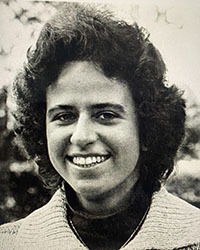
On Campus: Anne thought she wanted to be a journalist, so initially set her sights on the English department. After taking a few courses there, however, she realized “this wasn't for me; it wasn't going to help me be a journalist.” She took journalism courses at UMass and eventually contributed freelance pieces to the Hampshire Gazette, and in her senior year become Editor-in-Chief of Smith’s student newspaper, The Sophian.2 However, these experiences were eclipsed by a growing interest in Psychology.
Psych Department Memories: Anne’s experience in the Psychology department didn’t start well. In her first semester, she took Intro Psych with Don Reutener and failed the final exam, partly because of his focus on experimental psychology, and partly because “I didn’t think I had to study.”3 To Anne’s chagrin, her instructor for the follow-up course in the spring was also Don Reutener. She felt compelled to explain her lackluster Intro performance. Don was “very supporting and understanding.” Afterwards, “something just turned around,” and Anne ended up loving the new course, on experimental psychology: “I had a rat that I trained to do all these things.” She would later co-author a study with Don on humor appreciation, her first empirical publication. She fondly remembers the mutual and infectious student-teacher enthusiasm generated during the experience.
Anne was also influenced by a course in Clinical Psychology taught by Joel Bergman, a Clinical faculty member at Smith in the early- to mid 1970s. “We had practicum experiences with patients at Northampton State Hospital. I loved the exposure to all the different models of clinical intervention and psychotherapy. The patient I was assigned was very challenging to work with, but I loved thinking about how to motivate him.”
She conducted an honors thesis with Social Psychologist Fletcher Blanchard, receiving a designation of Highest Honors for her work. “[Fletcher] was another very positive, very encouraging professor. I learned a lot [from him] about conducting research, analyzing data, and also writing up papers. I'd be down in my space writing my thesis and getting discouraged, and [Fletcher] would be up in his office writing, burning the midnight oil. I feel very warmly toward Smith and the education I got, and especially the relationships with the professors.”
Graduate School: After graduating in 1977, Anne initially thought she would try teaching for a few years, but education jobs at that time were hard to come by. Her professors encouraged her to apply to graduate school. “Fletcher [Blanchard], Sue [Freeman, a psychologist in the Department of Education and Child Study, who also was an important mentor] and other people advised: if you can keep going, keep going.”
A graduate-school interview at UVA helped clarify her interests. The head of the program looked at her application and declared, “you've done, this, this, and this. You're a community psychologist.” Anne accepted UVA’s offer and pursued a PhD degree in clinical and community psychology. “I wanted the clinical training for sure; it's a good skill, and a way you can make a living. But the community piece really appealed to me for the context, the ecology of what was going on. You have to change systems in order to have large-scale behavioral change.”
Anne did her clinical internship at Yale School of Medicine. “It was a perfect match for me,” she recalls. She had two primary placements. One was in a community mental health clinic, where she did traditional clinical work with children and families. The other was called the “consultation center,” where Anne gained “broader, systems” experience by training staff in multiple service systems, serving as a consultant to schools, and assisting with a needs assessment for the state of Connecticut.
Employment: Her first job was Assistant Professor of Psychology at Temple University in Philadelphia. Anne soon realized that an arts-and-sciences environment made it difficult to continue her research on kids and families in health-care settings. After about three years at Temple, she spotted a “tiny” ad in the APA Monitor for a psychologist at the Division of Oncology at Children's Hospital of Philadelphia (CHOP). She got the position, which also included appointment as an Assistant Professor in the Department of Pediatrics at the University of Pennsylvania School of Medicine. This move “opened up many important doors” and laid the groundwork for much of her research. She stayed at CHOP and UPenn for 26 years, becoming the first Director of Psychology at CHOP and advancing to the rank of full professor at UPenn. Anne was lured to her most recent position—Enterprise Director of the Nemours Center for Healthcare Delivery Science, based in Willmington, DE—because of the close match between her research program and Nemours’ mission to support the delivery of health care to kids and families broadly. She also has an appointment as Professor in the Sidney Kimmel School of Medicine at Thomas Jefferson University and faculty appointments in the Department of Psychology and Brain Sciences at the University of Delaware (UD, as well as the College of Health Professions at UD.
Research: Anne has an impressive publication record. She’s co-authored four books and written two treatment manuals. However, the bulk of her work is in the form of empirical articles—approaching 250 in number—and doesn’t include additional book chapters, APA task force materials, and other documents. Many of Anne’s studies focuses on outcomes of disease—particularly in children—and their effects on families. She and colleagues have used a unique approach to study stress, coping, and psychological outcomes in many different populations. “A lot of what was being said [in the early 1980s] was actually quite negative. If you have a child with cancer, or with a developmental problem, or with cystic fibrosis or diabetes—whatever it might be—the thinking then was that this would tear your family apart.” Anne thought otherwise, in part because research she had conducted as early as her doctoral thesis had showed that biased samples could skew results and cause false positives. “A lot of the literature in this area was based on samples where there was some indication of clinical concern. If you went with a more distributed sample to try to get at that population, you would see a lot more variability; a lot more indications of resilience and success and confidence.”
Anne continues to apply this approach with a psychosocial screening tool that she’s developed. She and colleagues don’t just target families with obvious problems. “We assume that everybody will benefit, and that we, as providers, will learn and be better able to help people if we approach the full population with our sample.”
She’s also been Editor-in-Chief of several prominent academic journals, including Journal of Pediatric Psychology, Journal of Family Psychology, Health Psychology, and American Psychologist. Under her leadership, American Psychologist was “restructured to be much more like a standard journal with a smaller group of associate editors and a rigorous peer-review process. I really liked working with authors to prepare their submissions for publication and to have an impact that way.” Anne recently stepped down from these formal roles and is currently devoting her editing energies to continue mentoring others in their publishing pursuits. “There's no shortage of issues in academic publishing, one of the biggest now being open access.”
In recent years, Anne’s community psychology training—which she readily admits downplaying early in her career because people didn’t know what it was—has become more relevant than ever. “People are [now] talking about structural racism and the impact of the economy, the impact of the Covid pandemic. There’s a greater appreciation for broader systems.”
She used her community expertise to advise about Covid19, for example. “I felt frustration during the pandemic. I felt that, as behavioral scientists, we should be able to stop this from rolling out of control so quickly. As experts on human behavior and change, we should know how to motivate people to prevent disease, through masking or vaccines. I wanted to see psychology come to the fore. I don't know that we have.”
With colleagues, she developed a measure called the Covid19 Exposure and Family Impact Scale (CEFIS), which was finalized in the early days of April 2020. “I approached it from a traumatic stress framework, which was that a lot of the things happening in the early days of the pandemic were potentially traumatic to kids and families. What kind of stresses were they exposed to? What were the negative and positive impacts?” Papers by other colleagues using the scale have just begun to come out.
Anne has also studied health outcomes of transgender children and young adults, in collaboration with a pediatric gynecologist at Thomas Jefferson University. They’re particularly interested in aspects of the issue that have to do with menstrual management for her patients. “It’s an example of a project that I really see best as being a collaborator rather than the lead, in more of a mentoring role. It’s been a great experience in a new area that is important and fits within my worldview.”
Awards and Honors: Anne has received numerous awards, including the Smith College Medal in 2005, where she was “treated like a celebrity” when returning to campus with her wife and son, and the APA’s Presidential Citation in 2012. She’s circumspect about her success. “I set the bar high, so I always want to try to be doing more or solving more riddles in the world of research”; however, her ultimate goal is to “help families.”
Greatest Achievement: “I think it's the body of research to address competence in families struggling with childhood cancer. That's probably where I’m most well-known.”
Overcoming Challenges: “It’s still challenging to be a woman in a number of professions. The way to get over it is to connect with people, to get support from other women certainly. There's still many, many ways in which women are treated differently, and not always given the respect that we should have.”
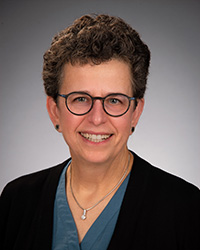
Finally, “there are a lot of systemic issues in in organizations. You may run into problems that are upsetting and persistent and challenging. You win some, you lose some; you certainly don't win all of them.”
Advice to Students Pursuing a Career in Pediatric Psychology: “Pediatric psychology is a booming field. It’s in division 54 of the APA, a growing and thriving division with lots of opportunities for students and early-career professionals. I would encourage students who are interested to pursue it. Over time, we're seeing growing appreciation for the integration of behavioral, emotional, and social aspects of the family into medical care. It's a great field to be in and expanding into lots of different areas and settings.”
Smith’s Impact: “Smith was a very encouraging and welcoming environment in terms of seeing and being with strong women. I was just a quiet kid from upstate New York. Over the course of my time at Smith I came out as a lesbian, but I didn't go to Smith knowing that that was the case. Having an environment that presented many different aspects of what you could be and how you could find yourself was important in lots of ways.” And finally, the friendships she formed with other students were just as important.
Footnotes
1 Unless otherwise noted, all quoted material is from an interview conducted with Maryjane Wraga on October 28, 2022.
2 By taking this position, Anne followed in the footsteps of another Psychology major and journalism lover, Betty Goldstein (Friedan) ’42.
3 Anne shared this anecdote specifically for current students. “I hope it helps people. I hope they realize not to get too upset about one bad grade.”
Select References
Kazak, A. (1989). Families of chronically ill children: A systems and social ecological model of adaptation and challenge. Journal of Consulting and Clinical Psychology, 57, 25-30.
Kazak, A. (2006). Pediatric Psychosocial Preventative Health Model (PPPHM): Research, practice and collaboration in pediatric family systems medicine. Families, Systems and Health, 24, 381-395.
Kazak, A., Hoagwood, K., Weisz, J., Hood, K., Vargas, L., & Banez, G. (2010). A meta-systems approach to evidence-based practice for children and adolescents. American Psychologist, 65, 85-97. PMID: 20141264.
Price, J., Kassam-Adams, N., Alderfer, M., Christofferson, J. & Kazak, A. (2016). An integrative model of pediatric medical traumatic stress: An update based on a systematic literature review. Journal of Pediatric Psychology, 41, 86-97.
Kazak, A., Deatrick, J., Scialla, M., Sandler, E., Madden, R. & Barakat, L. (2020). Implementation of family psychosocial risk assessment in pediatric cancer with the Psychosocial Assessment Tool (PAT): Study protocol for a cluster randomized comparative effectiveness trial. Implementation Science, 15, 60. https://doi.org/10.1186/s13012-020-01023-w. https://rdcu.be/b5Xof
Complete List of Published Work in My Bibliography
Anne also has a website of her photography, including a segment on state institutions.
Tomi-Ann Roberts ’85
Stealth Feminism and Conscious Collaborating
by Maryjane Wraga
Background: Tomi-Ann was raised in Upstate New York in the 1960s and 70s. Her family also spent summers in Finland, her mother’s birthplace. Her values were informed by her parents’ liberalism (“I have a very vivid image of my dad mowing our suburban lawn wearing an ERA—equal rights amendment—t-shirt”1) and the Scandinavian norms on gender equality and wealth equity she experienced in Finland.
Early Influences: Her fifth-grade teacher Mr. Xeller instilled a love of fiction but also taught Tomi-Ann how to think critically about what she was reading. Two cultural icons of the 1970s—actors Mary Tyler Moore and Marlo Thomas, the latter of whom wrote the book and television special Free to Be You and Me— were “very influential in terms of my coming to an understanding of myself as a woman in the world.”
Why Smith? In high school, Tomi-Ann was active in student government, but had never found the courage to run for president. She recalls drawing mental comparisons between the one-up-man-ship dynamics of that mostly male-run organization and, of all things, her girl scout troop. “I really liked my girl scout troop,” she concluded, “there was so much more collaboration.” She realized that an all-women’s institution might be an ideal setting for college.

Stealth Feminism: Another significant experience at Smith was participating in a student-led sit-in at College Hall to support divestment from South Africa. Tomi-Ann remembers it as a powerful experience, with students quietly holding their ground. Her generation—falling midway between Second Wave feminists and Gen-Xers—has been called stealth feminists. “We ‘stealths’ without a label have simply, and often quietly, practiced our feminism.”2
Me-Too Encounter: A theater lover since high school, Tomi-Ann also participated in local theater productions near home and at Smith. The summer of her junior year, she lived in New York City with friends, waiting tables to support herself while seeing if the acting angle might pan out professionally. On one shift she served Harvey Weinstein, then a little-known film producer, who invited her to his hotel for a movie script reading. As she has related elsewhere,3 Weinstein asked her to remove her top when she arrived. She refused. “I got out of that room!,” she recounted. She talked through the event with friends and family as a way to cope. “Although I blamed myself [rather than him], saying I wasn’t brave enough [to cut it in the movie business], I remember very vividly thinking that I had a lot of other options.” Options such as returning to Smith to complete her senior year.
Graduate School: Encouragement from some of her Smith Psychology professors (“they said I was graduate-school material, which amazed me”) persuaded Tomi-Ann to apply to the PhD program at Stanford University.
Conscious Collaborating: Because of her research interests, Tomi-Ann assumed she would work with well-known social psychologist David Rosenhan at Stanford. However, graduate students suggested she instead try a faculty member who had just arrived, Susan Nolan-Hoeksema. Nolan-Hoeksema turned out to be the ideal choice. “She was just the greatest mentor a person could ever asked for; we were collaborators truly. What pre-tenure faculty member asks their grad student what they want to study, and gives them first authorship?” Tomi-Ann also collaborated with social psychologist James Pennebaker, a visiting professor during her second year at Stanford. With both mentors, she began publishing a body of work on gender differences in self-evaluation.
Employment: After an early stint at Brigham Young University, where her feminist views were not quite stealth enough— getting her into “all kinds of trouble”—Tomi-Ann joined the faculty at Colorado College, where she’s been since 1993, serving over the years as Chair of the psychology department and director of the Feminist and Gender Studies Program. She was awarded the Colorado College Faculty Adviser of the Year in 1996 and 1998, and Teacher of the Year in 2014.

Professional Activities: Tomi-Ann has also been involved several task forces on gender and sexual harassment, including the APA Task Force on the Sexualization of Girls in 2005-2009. When asked whether she finds her applied or empirical work more impactful, she sees them as equally important. “I have always wanted to do empirical work that could walk out of the Academy and make a difference. It feels to me that objectification theory is meeting its feminist promise as potentially an agent of social change.”
Greatest Accomplishment of Career So Far: “I recently saw a paper [that referred to the 1997 article] whose title was ‘The theory that launched 1,000 papers.’” I would say objectification theory itself, but I suppose it’s not the paper but it's generativity. The greatest accomplishment is all the research that objectification theory has generated.”
Overcoming Challenges: The encounter with Harvey Weinstein was not the only personal sexism Tomi-Ann has experienced. “I’ve been surprised over and over again about how not feminist the world is.” She recounts an incident at a conference in which she participated on a panel with other psychologists. A male moderator was tasked with commenting on the panelists’ research presentations. When he got to Tomi-Ann’s work, he merely remarked on her appearance. Tomi-Ann offered the following coping strategy: “I regain my strength by returning to my collaborators, telling the story, laughing, tying it into the work: realizing that the work itself has to keep being done.” She also finds gratification in helping younger generations of women figure out how to get through similar kinds of demoralizing situations.
Advice for Pursuing a Career in Research Psychology: “You need to find an idea that you can live with for a long, long time. You want to make sure that you are not just applying to a program to work with a primary investigator who will allow you to crank out papers, although sometimes you have to pay your dues that way.”
You may instead land at a smaller program with a mentor “who you're going to be able to work with on the ideas that you can live with for a long, long time. It might not be Harvard; it's probably not, actually. And it doesn't have to be one idea, it can be a realm of ideas. Can you imagine hanging out in that realm for a while?
And then certainly do your research about mentors who are going to enable you to be your Smithie self!”
Footnotes
1 Unless otherwise noted, all quoted material is from an interview conducted over Zoom with Maryjane Wraga on July 1, 2022.
2 Fredrickson, B.L., Meyerhoff Hendler, L., Nilsen, S., Fox O’Barr, J., & Roberts, T.-A. (2011). Bringing back the body: A retrospective on the development of objectification theory. Psychology of Women Quarterly, 35(4), 689-696.
3 For example, see https://www.denverpost.com/2017/10/12/harvey-weinstein-harassed-colorado...
4 Gilligan, C. (1982). In a different voice. Cambridge, MA: Harvard University Press.
5 Fredrickson et al. (2011).
Select Publications
Fredrickson, B.L., & Roberts, T.-A. (1997). Objectification theory: Toward understanding women’s lived experience and mental health risks. Psychology of Women Quarterly, 21, 173-206.
Dunnavant, N. & Roberts, T-A (2013). Restriction and renewal, pollution and power, constraint and community: The paradoxes of religious women’s attitudes toward menstruation. Sex Roles, 68, 121-131.
Goldenberg, J.L. & Roberts, T-A. (2011). The birthmark: An existential account of the objectification of women. In R.M. Calogero, S.Tantleff-Dunn, & J.K. Thompson (Eds.), Self-Objectification in women: Causes, consequences, and counteractions (pp. 77-99). Washington, D.C.: American Psychological Association Press.
Roberts, T-A. (2016). Mind the thigh gap: Bringing feminist psychological science to the masses. In T-A. Roberts, N. Curtin, L.E. Duncan & L.M. Cortina (Eds.), Feminist Perspectives on Building a Better Psychological Science of Gender (pp. 275-293). New York, NY: Springer.
Roberts, T-A., Calogero, R.M. & Gervais, S.J. (2018). Objectification Theory’s continuing contribution to feminist psychology. In J. White and C. Travis (Eds.), APA Handbook of the Psychology of Women (pp. 249-271). Washington, DC: American Psychological Association.
Chitra Raghavan ’92
Dismantling Invisible Power Structures,
One Study at a Time
by Maryjane Wraga
Background: Chitra grew up in Malaysia in the 1970s and 80s. Both of her parents are of Indian descent, although her father was born in Malaysia and her mother was born in India, “a fairly unusual combination” for the region. Chitra has one older sister.
Early Influences: Her mother, a classical musician who had emigrated to Malaysia at a young age and had felt “dislocated” ever since, directed her energy toward her daughters. “She was anxious that we wouldn't grow up knowing India, and quite anxious that we wouldn't grow up intellectual.”
Why Smith?: Higher education wasn’t readily accessible to Chitra’s family, who had little money. At the time, “90-95% of scholarships were primarily for Malays.” Her options were “to do a technical degree, such as accounting, or study abroad.” She applied to a dozen overseas universities and bided her time working in an accounting firm, “trying to pretend that this is what I wanted,” in case things didn’t work out. A last-minute scholarship came through from Smith. Her family didn’t have a telephone, so she had to reply via FAX, causing a local stir. Chitra remembers “being in disbelief.” Her family was elated. Her father dipped into his retirement savings to pay for the airfare to the U.S.
Psych Department Memories: One of Chitra’s loves was archeology, but she worried about how practical a career it would be over time. “It was stern to police myself this way, but I wondered who would take care of my parents?” She changed her major to Psychology in her junior year before going abroad to study in Paris. Fortunately, the few Psychology courses she took at the Sorbonne—including one on behavioral modification that was “dryly Pavlovian”— did not put her off the major.
Back at Smith, the attitude in the Psychology department was “do what you want,” which appealed: “I still teach like that today.” Chitra was also impressed by how invested Psych professors were in their majors. “They were into their research. They were encouraging. They were about the future.” That combination of positivity and forward thinking was just what Chitra needed. “I became a sort-of poster child for the class of 1992. The Psych professors spent lots of time with me.” One particular influence was clinical psychologist Donna Nagata (now at the University of Michigan). Nagata is Japanese-American; her research focuses on Asian-American mental health. Chitra’s time in Nagata’s lab helped shape her “understanding of what it's like to be Asian in America.”
Graduate School: Chitra pursued a PhD in Community and Clinical Psychology at the University of Illinois Urbana-Champaign. “I liked how liberal they were. I also wanted the best possible education, a naïve approach. I didn't think about what it would be like to live in Illinois.” Chitra had a wonderful experience with her mentor Howard Berenbaum, despite the fact that she was lukewarm about her dissertation topic: self and identity. Interviewing local women for a related project revealed to her the power of bearing witness to the voiceless, however. “That's how I really started to love my work.” After completing her PhD in 1998, Chitra did a post-doc at Yale with Suzanne Swan, whose research focused on what women need in order to leave abusive relationships. It was a “radical” approach to the topic at the time. “Everyone else was saying, why aren't women leaving? And [Swan] was asking, what do women need to leave?”
Employment: Chitra joined the faculty of John Jay College of Criminal Justice in 2002. She is currently Professor of Psychology, Director of the Forensic Mental Health Counseling Program, and Coordinator for the Victimology Studies in Forensic Psychology.
Research: During her Yale postdoc, Chitra interviewed study participants at a domestic violence shelter. One day she received a response that would shape the trajectory of her own research. ‘Why don't you ask about things that really matter?” asked the female participant. “You don't see how much he [her abuser] controls me emotionally; how much power he has. All you do is ask about physical violence. [The power] is invisible.’” Chitra was struck by the word invisible. She suddenly remembered a conversation she had had a decade earlier, on a “snow-clad” midnight campus walk with a fellow Smithie, about invisible power structures that oppress women. That conversation had inspired her to read philosopher Michel Foucault’s views on pervasive, unseen power. “All three moments clicked.” Chitra realized that she didn’t “know anything about domestic violence in a meaningful way.”
She sought research on the topic in the literature and found the work of sociologist and social worker Even Stark, who had coined the concept coercive control to describe the invisible force that abusers use. Chitra began measuring coercive control and its traumatic outcomes in a variety of abuse situations, including intimate partner violence, sex trafficking, sexual harassment, and male same-sex relationships. “I started doing this research, and it was very unpopular. I got ridiculed a few times, but I was so used to not being in the majority from the time I was growing up with parents from different countries that I didn't pay attention to it.”
As her studies began to show consistent evidence of coercive control, Chitra became increasingly frustrated and “really angry that women were floundering in court because well-meaning clinicians and lawyers didn't have the language to explain how they were being controlled.” She began testifying in court, “arguing about coercive control and some of its outcomes, including trauma and the concept of trauma bonding,” which had yet to be introduced into the system. “People don't understand the power of the mind, the power of persuasion; the way it locks you and traps you.”
The New York judicial system began to take notice. Chitra’s research and testimony has resulted in new case law that allows for the admissibility of research on trauma-coerced attachment in court, despite it not currently being listed in the DSM-V. It’s now being used in other states, as well as the federal level. Chitra is “excited and bewildered” about the attention her research and expert testimony has brought. “I’m just doing the work I really want to do. And then suddenly I'm famous. It's bewildering, but it's a good bewilderment. I aggressively mentor my doctoral students to really push the boundaries. I want them to be better than me.”
Greatest Achievement: “Inspiring organizations, judges, lawyers, prosecutors, and defense attorneys to adopt coercive control into their evaluations because they can impact the largest number of populations for both women and same-sex relationships.”

Advice to Students Pursuing a Career in Psychology: “I have two pieces of advice. The first is to be OK with making choices that you're not sure about because you can change your mind later on. I committed to a field that I didn't know much about, and I studied different things, all of which I enjoyed. So, to really not feel like you have to specialize and be narrow, but to explore and enjoy. The second piece of advice is to be driven more by curiosity and love than by safety. If you don't quite like A, then try B, and just kept adding to your world of language and ideas, driven by curiosity.”
Footnote
1 All quotes are from an interview with Maryjane Wraga on September 1, 2022.Select References
Doychak, K & Raghavan, C. (2018). “No voice or cote:” trauma-coerced attachment in victims of sex trafficking. Journal of Human Trafficking. DOI: https://doi.org/10.1080/23322705.2018.1518625
Kaplenko, H., Loveland, J. E., & Raghavan, C. (2018). Relationships among shame, restrictiveness, authoritativeness, and coercive control in men mandated to batterer treatment. Violence and Victims, 33(2), 296-309.
Legg, A., & Raghavan, C. (2020). Not Safe for All: A Mixed Methods Study of Violence in Men in Commercial Sex. Psychology of Sexual Orientation and Gender Diversity. Advance Online Publication. https://doi.apa.org/doi/10.1037/sgd0000374
Mitchell, J., & Raghavan, C. (2021). The impact of coercive control on use of specific sexual coercion tactics. Violence Against Women. 1077801219884127.
Pomerantz, J., Cohen, S.J., Doychak, K., Raghavan, C. (2021). Linguistic Indicators of Coercive Control: in Sex Trafficking Narratives. Violence and Gender. DOI: 10.1089/vio.2020.0105. In the press: https://www.nytimes.com/2022/01/10/style/love-bombing.html
William S. Ryan ’09
Identity Development in Life and Research
Background: Will grew up in western New York State in the 1990s-2000s.
Early Influences: “I have a pretty unique and privileged experience in that my dad is a clinical psychologist, a Professor of Psychology at the University of Rochester. I grew up around all of that, and in fact reacted against it, saying I’m going to be different.’“1 Because of his involvement in the church, Will initially thought he wanted to be a youth minister. One book changed everything. During his senior year of high school, he and his family went on vacation. “It was raining the whole time, and we were stuck in a cabin.” Will passed the time by reading one of the many books his father had brought along. Will found the material fascinating and realized that he was “interested in understanding what attracts people to do what they do.” The title of the book? The Handbook of Experimental Existential Psychology.
Why Smith?: When Will applied to college, he self-identified as a straight woman. His mother drove him to tour Smith, but he refused to even get out of the car. “I like boys, I need to be at a school that has boys!” is the reaction he recalls. Instead, Will went to McGill University, which was coed and also international. But McGill had some downsides, such as large classes that left Will feeling “lost in the crowd.” During that year he also came out as a lesbian. He realized, “I really do want to go to a woman’s college!” and transferred to Smith for sophomore year.
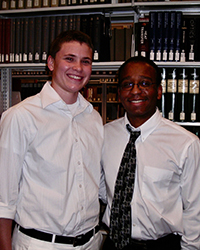
Independent Project in Sociology: After taking a course on Queer Resistances with Sociology professor Nancy Whittier, Will also worked with her on a project examining theories of self that bridged psychological and sociological theories, with a specific focus on identity labels.
Identity Transitions: Will discusses the evolution of his identity with honesty, grace, and humor. He attributes his time at Smith as playing an integral role in the process. Upon arrival on campus, “I was newly out as lesbian and very anxious about the fact that real lesbians on campus would be able to tell that I didn't know what I was doing.” Toward the end of his junior year, that defensiveness returned over another issue. “One of my friends came out as trans. My initial reaction was, ‘Why can’t he just be butch? If he wants to be a man, why would he want to be at Smith?’ My girlfriend at the time was like ‘Wow, you seem to have a lot of feelings about that; you might want to unpack where that's coming from.’ I didn’t realize that I was struggling with my own identity and how that fit at Smith.” The strong defensive response was a clue that something more was going on. Will came out as a trans man about a month later. “I'm not sure I would have become the man I am today without everybody at Smith—both the professors and students —pushing my thinking around what masculinity is and can be. I am grateful to all of my Smithies for affirming my trans identity while helping me push against traditional notions of masculinity.”
After Smith: Will took two years off between college and grad school. “I wasn't sure what type of psychology I wanted to study: I was still very torn between social and clinical.” He also made the “gay pilgrimage” to San Francisco. He met a new group of Smithies and worked at a residential facility for youth with emotional and behavioral problems, a job that provided hands-on experience in applied clinical psychology.
Graduate School: Will attended UC Santa Barbara and worked with Dr. Jim Blascovich at the Research Center for Virtual Environments and Behavior. It wasn’t a good fit, mostly because Blascovich was preparing to retire. “There were no active projects. I was holding up the lab, maintaining a ton of equipment, helping people finish their own projects, and getting little credit for the work.” A chance conversation with another student led to a collaboration on integrating cardiovascular measurements into fMRI, a line of research that Will worked on and off for a decade. The best part of grad school was the large, supportive cohort of graduate students, including Molly Metz, who would later become his spouse. Molly’s adviser provided Will with the mentoring he needed to complete his PhD in 2017.
Employment: Will’s experience at Santa Barbara left him feeling burnt out; he took his time finding a job after graduate school.2 He followed Molly, first to Ohio and then to Toronto working remotely as a consultant while they tried to solve the “two body” problem. Eventually, Will was able to start teaching at the University of Toronto as well, first as a part-time lecturer and now in a full-time, teaching-focused position.

Professional Activities: Will is a Behavioral Scientist and Independent Research Consultant for Immersyve, Inc., a company that creates research-based well-being protocols for companies. Will is also a member of several professional associations, including The Society for the Teaching of Psychology, Society for Personality and Social Psychology, and Society for the Scientific Study of Sexuality.
Advice for Those Struggling with Identity: “The first thing would be to give yourself some self-compassion. Treat yourself the way you might treat a friend who’s having a hard time. We are often not kind to ourselves. Recognize that your struggles are common. Identity is a human problem; just by the nature of being human we struggle with identity. I don't mean to minimize anyone’s experience, but you're not alone. Humans before us have struggled with this, and everybody after us will struggle with this. You don't have to have it all figured out; you don't have to make one final choice around identity. It's a changing, growing thing. You can always integrate more things into an identity. You can also create new identities and leave old ones behind.”
Advice for Pursuing a Career in Psychology: “Take as much stats as you can; I can't oversell that. Even if you don't want to go to grad school, stats are important for so many jobs; statistical literacy is becoming a basic life skill. Get involved in research, to see what you like about it. Read as much as you can about a variety of interests; you never know what will connect to later work. Even if you don't like what you're doing right now, see what you can learn from it for your next step. If you do go to grad school, don’t be the last person in someone’s lab. Talk to other graduate students, and listen to what they tell you.”
Footnotes
1 All quoted material is from a Zoom interview with Maryjane Wraga on August 4, 2022.
2 For more candid discussion of Will and others’ negative experiences in academia, see Jaremka, L. M., Ackerman, J. M., Gawronski, B., Rule, N. O., Sweeny, K., Tropp, L. R., Metz, M.A., Molina, L., Ryan, W. S., & Vick, S. B. (2020). Common academic experiences no one talks about: Repeated rejection, impostor syndrome, and burnout. Perspectives on Psychological Science, 15, 519-543.
Selected References
Johnston, P. R.*, Volkov, A.E.*, & Ryan, W.S., & Lee, S.W.S. (2022). Planning, conducting, and analyzing a psychophysiological experiment on challenge and threat: A practical guide. Behaviour Research Methods. https://doi.org/10.3758/s13428-022-01817-4
Moors, A., Ryan, W. S., & Chopik, W. B., (2019). Multiple loves: The effects of attachment with multiple concurrent romantic partners on relational functioning. Personality & Individual Differences, 147, 102-110.
Ryan, W. S., & Ryan, R. M. (2019). Toward a social psychology of authenticity: Exploring within-person variation in self-disclosure, congruence, and genuineness using self-determination theory. Review of General Psychology, 23, 99-112.
Ryan, W. S., Hunger, J. M., & Major, B. N. (2017). Applying Intergroup Relations to Understanding LGB Health Disparities Threat. Journal of Social Issues. 73(3), 477-492.
Ryan, W. S., Legate, N., Weinstein, N. & Rahman, Q. (2017). Autonomy support fosters lesbian, gay, and bisexual identity disclosure and wellness, especially for those with internalized homophobia. Journal of Social Issues, 73, 289-306.
Contact
Bass Hall 417
Smith College
Northampton, MA 01063
Administrative Assistant:
Laura Fountain-Cincotta
Individual appointments may be arranged directly with faculty.
Director of Honors: Patricia DiBartolo (2022-2023)
Director of Intro: Michele Wick (Fall 2022)





